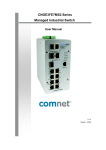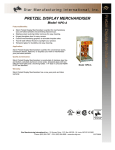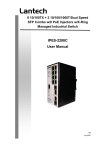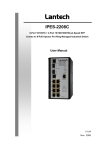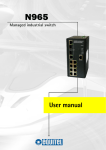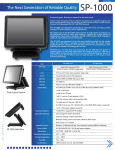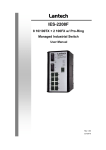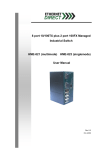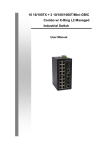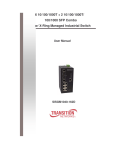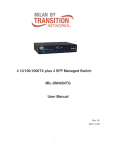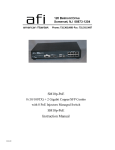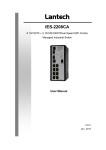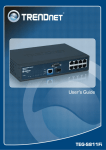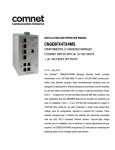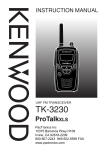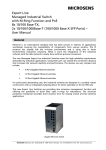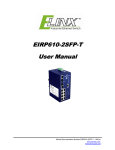Download 8 10/100TX + 2 10/100/1000T/Mini-GBIC Combo with 8 PoE Injector
Transcript
8 10/100TX + 2 10/100/1000T/Mini-GBIC Combo with 8 PoE Injector Industrial Switch User Manual SISPM1040-182D Version 1.01 October, 2009 Transition Networks SISPM1040-182D Revision History Document Date Revision Initials 1.00 Oct 31, 2008 First release A.E.F 1.01 Oct 21, 2009 Corrections A.E.F Release Technical Support: 1-800-260-1312 International: 00-1-952-941-7600 Transition Networks SISPM1040-182D Notice The contents of this manual are based on the table below listing firmware version, kernel version, and hardware version. If the switch functions are different from the description of the manual, please contact the local sale dealer for more information. Firmware Version V1.00 Kernel Version V1.56 Hardware Version ---------- Technical Support: 1-800-260-1312 International: 00-1-952-941-7600 Transition Networks SISPM1040-182D FCC Warning This Equipment has been tested and found to comply with the limits for a Class-A digital device, pursuant to Part 15 of the FCC rules. These limits are designed to provide reasonable protection against harmful interference in a residential installation. This equipment generates, uses, and can radiate radio frequency energy. It may cause harmful interference to radio communications if the equipment is not installed and used in accordance with the instructions. However, there is no guarantee that interference will not occur in a particular installation. If this equipment does cause harmful interference to radio or television reception, which can be determined by turning the equipment off and on, the user is encouraged to try to correct the interference by one or more of the following measures: Reorient or relocate the receiving antenna. Increase the separation between the equipment and receiver. Connect the equipment into an outlet on a circuit different from that to which the receiver is connected. Consult the dealer or an experienced radio/TV technician for help. CE Mark Warning This is a Class-A product. In a domestic environment this product may cause radio interference in which case the user may be required to take adequate measures. Technical Support: 1-800-260-1312 International: 00-1-952-941-7600 Transition Networks SISPM1040-182D Content Chapter 1 Introduction......................................... 1 1.1 Hardware Features...................................... 1 1.2 Software Features ....................................... 5 1.3 Package Contents ....................................... 8 Chapter 2 Hardware Description ........................ 9 2.1 Physical Dimension ..................................... 9 2.2 Front Panel.................................................. 9 2.3 Bottom View .............................................. 10 2.4 LED Indicators........................................... 11 Chapter 3 Hardware Installation ....................... 13 3.1 Installation Steps ....................................... 13 3.2 DIN-Rail Mounting ..................................... 14 3.3 Wall Mount Plate Mounting ....................... 16 3.4 Wiring the Power Inputs ............................ 17 3.5 Wiring the Fault Alarm Contact ................. 18 3.6 Cabling ...................................................... 19 Chapter 4 Network Application......................... 23 4.1 X-Ring Application..................................... 25 4.2 Coupling Ring Application ......................... 26 4.3 Dual Homing Application ........................... 27 4.4 Dual Ring Application ................................ 28 Chapter 5 Console Management ...................... 29 5.1 Connecting to the Console Port ................ 29 5.2 Pin Assignment ......................................... 29 Technical Support: 1-800-260-1312 International: 00-1-952-941-7600 Transition Networks SISPM1040-182D-LR 5.3 Login in the Console Interface................... 30 5.4 CLI Management....................................... 32 5.5 Commands Level ...................................... 32 Chapter 6 Web-Based Management................. 34 6.1 About Web-based Management................ 34 6.2 Preparing for Web Management ............... 34 6.3 System Login............................................. 35 6.4 System Information ................................... 36 6.5 IP Configuration......................................... 37 6.6 DHCP Server............................................. 39 6.7 TFTP ......................................................... 43 6.8 System Event Log ..................................... 46 6.9 Fault Relay Alarm...................................... 52 6.10 SNTP Configuration ................................. 53 6.11 IP Security ................................................ 57 6.12 User Authentication .................................. 59 6.13 Port Statistics ........................................... 60 6.14 Port Control .............................................. 62 6.15 Port Trunk................................................. 64 6.16 Port Mirroring............................................ 74 6.17 Rate Limiting ............................................ 75 6.18 VLAN configuration .................................. 77 6.19 Rapid Spanning Tree ............................... 87 6.20 SNMP Configuration................................. 91 6.21 QoS Configuration.................................... 97 Technical Support: 1-800-260-1312 International: 00-1-952-941-7600 Transition Networks SISPM1040-182D-LR 6.22 IGMP Configuration................................ 100 6.23 X-Ring..................................................... 102 6.24 LLDP Configuration ................................ 105 6.25 Security—802.1X/Radius Configuration. 106 6.26 MAC Address Table ............................... 110 6.27 Power over Ethernet............................... 115 6.28 Factory Default ....................................... 117 6.29 Save Configuration................................. 118 6.30 System Reboot ....................................... 119 Troubles shooting ................................................. 120 Appendix A—RJ-45 Pin Assignment ................... 121 RJ-45 Pin Assignments........................................ 121 RJ-45 Pin Assignment of PoE.............................. 124 Appendix B—Command Sets............................... 126 System Commands Set ....................................... 126 Port Commands Set............................................. 128 Trunk Commands Set .......................................... 131 VLAN Commands Set.......................................... 132 Spanning Tree Commands Set............................ 134 QOS Commands Set ........................................... 137 IGMP Commands Set .......................................... 138 Mac / Filter Table Commands Set ....................... 138 SNMP Commands Set......................................... 139 Port Mirroring Commands Set ............................. 142 802.1x Commands Set ........................................ 142 Technical Support: 1-800-260-1312 International: 00-1-952-941-7600 Transition Networks SISPM1040-182D-LR TFTP Commands Set .......................................... 145 SystemLog, SMTP and Event Commands Set .... 145 SNTP Commands Set.......................................... 147 X-ring Commands Set.......................................... 148 Technical Support: 1-800-260-1312 International: 00-1-952-941-7600 Transition Networks SISPM1040-182D Chapter 1 Introduction The 8 10/100TX + 2 10/100/1000T/Mini-GBIC Combo w/8 PoE Injectors Managed Industrial Switch is a cost-effective solution and meets the high reliability requirements demanded by industrial applications. Fiber can extend the connection distance to increases the network elasticity and performance. In addition, the industrial switch provides the PoE function for Powered Devices to receive power as well as data over the RJ-45 cable. 1.1 Hardware Features IEEE 802.3 10Base-T Ethernet IEEE 802.3u 100Base-TX/ FX IEEE802.3ab 1000Base-T IEEE802.3z Gigabit fiber IEEE802.3x Flow Control and Back Pressure IEEE802.3ad Port trunk with LACP Standard IEEE802.3af Power over Ethernet IEEE802.1d Spanning Tree/ IEEE802.1w Rapid Spanning Tree IEEE802.1p Class of Service IEEE802.1Q VLAN Tag IEEE 802.1x User Authentication (Radius) IEEE802.1ab LLDP Switch Back-plane (Switching Fabric): 5.6Gbps Architecture Packet throughput ability(Full-Duplex): 8.3Mpps @64bytes 14,880pps for Ethernet port Transfer Rate 148,800pps for Fast Ethernet port 1,488,000pps for Gigabit Fiber Ethernet port Packet Buffer Technical Support: 1-800-260-1312 1Mbits International: 00-1-952-941-7600 Transition Networks SISPM1040-182D-LR MAC Address 8K MAC address table Flash ROM 4Mbytes DRAM 32Mbytes 10/100TX: 8 x RJ-45 Connector 10/100/1000T/ Mini-GBIC Combo: 2 x RJ-45 + 2 x 100/1000 SFP sockets RS-232 connector: RJ-45 type 10Base-T: 2-pair UTP/STP Cat. 3, 4, 5/ 5E cable EIA/TIA-568 100-ohm (100m) Network Cable 100Base-TX: 2-pair UTP/STP Cat. 5/ 5E cable EIA/TIA-568 100-ohm (100m) 1000Base-TX: 2-pair UTP/STP Cat. 5/ 5E cable EIA/TIA-568 100-ohm (100m) Distance: Multi mode: 0 to 5 km, 1300 nm (50/125 ȝm, 800 MHz*km) 0 to 4 km, 1300 nm (62.5/125 ȝm, 500 MHz*km) Single mode: 0 to 40 km, 1310 nm (9/125 ȝm, 3.5 PS/(nm*km)) 0 to 80 km, 1550 nm (9/125 ȝm, 19 PS/(nm*km)) Optical Fiber Min. TX Output: Multi mode: -20 dBm Single mode: 0 to 40 km, -5 dBm; 0 to 80 km, -5 dBm Max. TX Output: Multi mode: -14 dBm Single mode: 0 to 40 km, 0 dBm; 0 to 80 km, 0 dBm Sensitivity: -36 to -32 dBm (Single mode); -34 to -30 dBm (Multi mode) PoE pin RJ-45 port # 1~# 8 support IEEE 802.3af End-point, assignment Alternative A mode. Per port provides 15.4W ability. Technical Support: 1-800-260-1312 International: 00-1-952-941-7600 2 Transition Networks SISPM1040-182D-LR Positive (VCC+): RJ-45 pin 1,2. Negative (VCC-): RJ-45 pin 3,6. Protocol CSMA/CD Per unit: Power (Green), Power 1 (Green), Power 2 (Green), Fault (Red), Master (Green), FWD (Green) LED 8 port 10/100: Link/Activity (Green), Full duplex/Collision (Amber) SFP port: LNK/ACT(Green), 1000T: LNK/ACT(Green), 1000M(Green) External Power Supply: DC 48V, Redundant power DC 48V Power Supply and connective removable terminal block for master and slave power Power Consumption Operating Humidity 116Watts (Full load) 5% to 95% (Non-condensing) Operating Standard: -10oC ~ 60oC Temperature Wide Operating Temperature: -40oC ~ 75oC Storage Temperature -40oC ~ 85oC Case Dimension IP-30, 72mm (W) x 105mm (D) x 152mm (H) Fan Number 0 Installation DIN rail and wall mount ear FCC Class A, CE EN61000-4-2, CE EN61000-4-3, CE EN- EMI 61000-4-4, CE EN61000-4-5, CE EN61000-4-6, CE EN61000-4-8, CE EN61000-4-11, CE EN61000-4-12, CE EN61000-6-2, CE EN61000-6-4 Safety UL, cUL, CE/EN60950-1 Technical Support: 1-800-260-1312 International: 00-1-952-941-7600 3 Transition Networks Stability Testing SISPM1040-182D-LR IEC60068-2-32 (Free fall), IEC60068-2-27 (Shock), IEC60068-2-6 (Vibration) Technical Support: 1-800-260-1312 International: 00-1-952-941-7600 4 Transition Networks SISPM1040-182D-LR 1.2 Software Features Management SNMP v1 v2c, v3/ Web/Telnet/CLI RFC 1215 Trap, RFC1213 MIBII, RFC 1157 SNMP MIB, RFC 1493 SNMP MIB Bridge MIB, RFC 2674 VLAN MIB, RFC 1643 , RFC 1757, RSTP MIB, Private MIB, LLDP MIB Port Based VLAN VLAN IEEE 802.1Q Tag VLAN (256 entries)/ VLAN ID (Up to 4K, VLAN ID can be assigned from 1 to 4096.) GVRP (256 Groups) Port Trunk with LACP Port Trunk: 4 Trunk groups/Maximum 4 trunk LACP members LLDP** Spanning tree Supports LLDP allowing switch to advertise its identification and capability on the LAN IEEE802.1d spanning tree IEEE802.1w rapid spanning tree. Supports X-ring, Dual Homing, Couple Ring and Dual Ring X-Ring Topology Provides redundant backup feature and the recovery time below 20ms Quality of Service Class of Service Port Security The quality of service determined by port, Tag and IPv4 Type of service, IPv4/IPv6 Different Service Supports IEEE802.1p class of service, per port provides 4 priority queues Supports 100 entries of MAC address for static MAC and another 100 for MAC filter Technical Support: 1-800-260-1312 International: 00-1-952-941-7600 5 Transition Networks Port Mirror IGMP SISPM1040-182D-LR Supports 3 mirroring types: “RX, TX and Both packet”. Supports IGMP snooping v1,v2 256 multicast groups and IGMP query Supports 10 IP addresses that have permission to access IP Security the switch management and to prevent unauthorized intruder. Login Security Supports IEEE802.1X Authentication/RADIUS Support ingress packet filter and egress packet limit The egress rate control supports all of packet type and the limit rates are 100K~102400Kbps(10/100), Bandwidth Control 100K~256000Kbps(1000) Ingress filter packet type combination rules are Broadcast/Multicast/Unknown Unicast packet, Broadcast/Multicast packet, Broadcast packet only and all of packet. The packet filter rate can be set from 100K~102400Kbps(10/100), 100K~256000Kbps(1000) Flow Control System Log SMTP Relay Alarm Supports Flow Control for Full-duplex and Back Pressure for Half-duplex Supports System log record and remote system log server Supports SMTP Server and 6 e-mail accounts for receiving event alert Provides one relay output for port breakdown, power fail Alarm Relay current carry ability: 1A @ DC24V 1. Cold start SNMP Trap 2. Link down 3. Link up Technical Support: 1-800-260-1312 International: 00-1-952-941-7600 6 Transition Networks SISPM1040-182D-LR 4. Authorization fail 5. PD disconnect trap-PoE port event DHCP DNS Provides DHCP Client/ DHCP Server/ Port and IP Binding Provides DNS client feature and supports Primary and Secondary DNS server SNTP Supports SNTP to synchronize system clock in Internet Firmware Update Supports TFTP firmware update, TFTP backup and restore. Configuration Supports binary format configuration file for system quick Upload/Download installation ifAlias Each port allows importing 128bits of alphabetic string of word on SNMP and CLI interface Technical Support: 1-800-260-1312 International: 00-1-952-941-7600 7 Transition Networks SISPM1040-182D-LR 1.3 Package Contents Please refer to the package content list below to verify them against the checklist. 8 10/100TX + 2 10/100/1000T/Mini-GBIC Combo w/8 PoE Injectors Managed Industrial Switch x 1 User manual x 1 Pluggable Terminal Block x 1 Mounting plate x 2 RJ-45 to DB9-Female cable x 1 Compare the contents of the industrial switch with the standard checklist above. If any item is damaged or missing, please contact the local dealer for service. Technical Support: 1-800-260-1312 International: 00-1-952-941-7600 8 Transition Networks SISPM1040-182D Chapter 2 Hardware Description This chapter will describe the Industrial switch’s hardware spec, port, cabling information, and wiring installation. 2.1 Physical Dimension 8 10/100TX w/ X-Ring Managed Industrial Switch dimension (W x D x H) is 72mm x 105mm x 152mm 2.2 Front Panel The Front Panel of the 8 10/100TX w/ X-Ring Managed Industrial Switch is shown as below: Front Panel of the industrial switch Technical Support: 1-800-260-1312 International: 00-1-952-941-7600 Transition Networks SISPM1040-182D-LR 2.3 Bottom View The bottom panel of the 8 10/100TX w/ X-Ring Managed Industrial Switch has one terminal block connector for two (2) DC power inputs and one fault alarm. Bottom Panel of the industrial switch Technical Support: 1-800-260-1312 International: 00-1-952-941-7600 10 Transition Networks SISPM1040-182D 2.4 LED Indicators The diagnostic LEDs that provide real-time status information are located on the front panel of the industrial switch. The following table provides the description of the LED status and their meanings. LED Color PWR Green Status On The switch unit is powered on Off No power On R.M. PWR2 FAULT The industrial switch is the master of the X-Ring group Green Off PWR1 Meaning The industrial switch is not a ring master in the X-Ring group On Power 1 is active Off Power 1 is inactive On Power 2 is active Off Power 2 is inactive On Power or port failure Off No failures On A network device is detected. Green Green Red Green (Upper LED) Blinking The port is transmitting or receiving packets from the TX device. P9, P10 (RJ45) Green (Lower LED) Technical Support: 1-800-260-1312 Off No device attached On 1000M Off 10/100M International: 00-1-952-941-7600 Transition Networks SISPM1040-182D-LR On The SFP port is linking Link/Active (P9, P10 Green Blinks SFP) Green Amber No device attached On A network device is detected. Blinking from the TX device. No device attached The port is operating in full-duplex mode. Blinking Collision of Packets occurs. Green P8) The port is transmitting or receiving packets On Off FWD (P1 ~ from the TX device. Off Off P1 ~ P8 The port is transmitting or receiving packets The port is in half-duplex mode or no device is attached. A powered device is connected utilizing Power over Ethernet on the port Green Off No device is connected or power forwarding fails Technical Support: 1-800-260-1312 International: 00-1-952-941-7600 12 Transition Networks SISPM1040-182D Chapter 3 Hardware Installation This chapter describes how to physically install the 8 10/100TX w/ X-Ring Managed Industrial Switch. 3.1 Installation Steps 1. Unpack the Industrial switch 2. Check if the DIN-Rail is screwed on the Industrial switch or not. If the DIN-Rail is not screwed on the Industrial switch, please refer to DIN-Rail Mounting section for DINRail installation. If users want to wall mount the Industrial switch, please refer to Wall Mount Plate Mounting section for wall mount plate installation. 3. Hang the Industrial switch on the DIN-Rail track or wall. 4. Power on the Industrial switch. Please refer to the Wiring the Power Inputs section for information about how to wire power. The power LED on the Industrial switch will light up. Please refer to the LED Indicators section. 5. Prepare the twisted-pair, straight through Category 5 cable for Ethernet connection. 6. Insert one side of RJ-45 cable (category 5) into the Industrial switch Ethernet port (RJ-45 port) and another side of RJ-45 cable (category 5) to the network device’s Ethernet port (RJ-45 port), ex: Switch PC or Server. The UTP port (RJ-45) LED on the Industrial switch will light up when the cable is connected with the network device. Please refer to the LED Indicators section. [NOTE] Make sure that the connected network devices support MDI/MDI-X. If it does not support, use the crossover category-5 cable. 7. When all connections are set and LED lights all show normal, the installation is complete. Technical Support: 1-800-260-1312 International: 00-1-952-941-7600 Transition Networks SISPM1040-182D-LR 3.2 DIN-Rail Mounting The DIN-Rail is factory installed. If the DIN-Rail is not screwed on the industrial switch, please see the following pictures. Follow the steps below to hang the industrial switch. Technical Support: 1-800-260-1312 International: 00-1-952-941-7600 14 Transition Networks SISPM1040-182D 1. First, insert the top of DIN-Rail into the track. 2. Then, lightly push the DIN-Rail into the track. 3. Verify the DIN-Rail is tightened. 4. To remove the industrial switch from the track, reverse above steps. Technical Support: 1-800-260-1312 International: 00-1-952-941-7600 Transition Networks SISPM1040-182D 3.3 Wall Mount Plate Mounting Follow the steps below to mount the industrial switch with wall mount plate. 1. Remove the DIN-Rail from the industrial switch; loose the screws to remove the DINRail. 2. Place the wall mount plate on the rear panel of the industrial switch. 3. Use the screws to screw the wall mount plate on the industrial switch. 4. Use the hook holes at the corners of the wall mount plate to hang the industrial switch on the wall. 5. To remove the wall mount plate, reverse the above steps. Technical Support: 1-800-260-1312 International: 00-1-952-941-7600 Transition Networks SISPM1040-182D 3.4 Wiring the Power Inputs Please follow the steps below to insert the power wire. 1. Insert AC or DC power wires into the contacts 1 and 2 for power 1, or 5 and 6 for power 2. 2. Tighten the wire-clamp screws. [NOTE] The wire gauge should be in the range 12 ~ 24 AWG. Technical Support: 1-800-260-1312 International: 00-1-952-941-7600 Transition Networks SISPM1040-182D 3.5 Wiring the Fault Alarm Contact The fault alarm contacts are in the middle of the terminal block connector as the picture below shows. If configured the switch will detect power failure, or port link failure (available for managed model) and then form an open circuit. The following illustration shows an application example for wiring the fault alarm contacts. Insert the wires into the fault alarm contacts [NOTE] The wire gauge for the terminal block should be in the range between 12 ~ 24 AWG. Technical Support: 1-800-260-1312 International: 00-1-952-941-7600 Transition Networks SISPM1040-182D 3.6 Cabling Use four twisted-pair, Category 5e or above cabling for RJ-45 port connection. The cable between the switch and the link partner (switch, hub, workstation, etc.) must be less than 100 meters (328 ft.) long. Fiber segment using single-mode connector type must use 9/125 μm single-mode fiber cable. User can connect two devices in the distance up to 30km. Fiber segment using multi-mode connector type must use 50 or 62.5/125 μm multimode fiber cable. User can connect two devices up to 2km distances. Gigabit Copper/SFP (mini-GBIC) combo port: The Industrial switch has auto-detected Giga port—Gigabit Copper/SFP combo ports. The Gigabit Copper (10/100/1000T) ports should use Category 5e or above UTP/STP cable for the connection up to 1000Mbps. The small form-factor pluggable (SFP) is a compact optical transceiver used in optical communications for both telecommunication and data communications. The SFP slots supporting dual mode can switch the connection speed between 100 and 1000Mbps. They are used for connecting to the network segment with single or multi-mode fiber. Choose the appropriate SFP transceiver to plug into the slots. Then use proper multi-mode or single-mode fiber according to the transceiver. Fiber optic signals transmit at speeds up to 1000 Mbps and are immune to electrical interference. Note The SFP/Copper Combo port can’t both work at the same time. The SFP port has higher priority than the copper port; if you insert the 1000M SFP transceiver (connected to the remote device via fiber cable) into the SFP port, the connection of the accompanying copper port link will down. If you insert the 100M SFP transceiver into the SFP port even without a fiber connection to the remote, the connection of the accompanying copper port will link down immediately. Technical Support: 1-800-260-1312 International: 00-1-952-941-7600 Transition Networks SISPM1040-182D-LR To connect the transceiver and LC cable, please follow the steps shown below: First, insert the transceiver into the SFP module. Notice that the triangle mark is the bottom of the module. Transceiver to the SFP module Transceiver Inserted Second, insert the fiber cable of LC connector into the transceiver. Technical Support: 1-800-260-1312 International: 00-1-952-941-7600 20 Transition Networks SISPM1040-182D-LR LC connector to the transceiver Technical Support: 1-800-260-1312 International: 00-1-952-941-7600 21 Transition Networks SISPM1040-182D-LR To remove the LC connector from the transceiver, please follow the steps shown below: First, press the upper side of the LC connector to release from the transceiver and pull it out. Remove LC connector Second, push down the metal loop and pull the transceiver out by the plastic handle. Pull out from the transceiver Technical Support: 1-800-260-1312 International: 00-1-952-941-7600 22 Transition Networks SISPM1040-182D Chapter 4 Network Application This chapter illustrates some example applications. Below is a typical industrial switch application: Technical Support: 1-800-260-1312 International: 00-1-952-941-7600 Transition Networks SISPM1040-182D-LR The illustration below shows an example power over Ethernet application. Technical Support: 1-800-260-1312 International: 00-1-952-941-7600 24 Transition Networks SISPM1040-182D 4.1 X-Ring Application The industrial switch supports the X-Ring protocol that can help the network recover from connection failure within 20ms or less, and make the network system more reliable. The X-Ring algorithm is similar to spanning tree protocol (STP) algorithm but its recovery time is faster than STP. The following figure is a sample X-Ring application. Technical Support: 1-800-260-1312 International: 00-1-952-941-7600 Transition Networks SISPM1040-182D 4.2 Coupling Ring Application A network may have more than one X-Ring group. The coupling ring function can connect each X-Ring for redundant backup. It can ensure transmissions between two ring groups do not fail. The following figure illustrates a coupling ring application. Technical Support: 1-800-260-1312 International: 00-1-952-941-7600 Transition Networks SISPM1040-182D 4.3 Dual Homing Application The Dual Homing function prevents lost connection between an X-Ring group and an upper level/core switch. Assign two ports to be the Dual Homing ports in the X-Ring group. The Dual Homing function only works when the X-Ring function is active. Each XRing group only has one Dual Homing port. [NOTE] In Dual Homing application architecture, the upper level switches need to enable the Rapid Spanning Tree protocol. Technical Support: 1-800-260-1312 International: 00-1-952-941-7600 Transition Networks SISPM1040-182D 4.4 Dual Ring Application Dual ring is an advanced function that supports backup connection to ensure redundant transmission. If the connection fails, the system will recover from fwithin 20 milliseconds. Apart from that, Dual Ring only needs one unit (and only the one located in the middle) to be configured as the Ring Master switch to deploy the dual ring. Technical Support: 1-800-260-1312 International: 00-1-952-941-7600 Transition Networks SISPM1040-182D Chapter 5 Console Management 5.1 Connecting to the Console Port The supplied cable has an RS-232 connector on one end and an RJ-45 connector on the other end. Attach the RS-232 connector to a PC or terminal and the other end of RJ-45 connector to the console port of the switch. The connected terminal or PC must support the terminal emulation program. 5.2 Pin Assignment DB9 Connector RJ-45 Connector Technical Support: 1-800-260-1312 NC 1 Orange/White 2 2 Orange 3 3 Green/White NC 4 Blue 5 5 Blue/White NC 6 Green NC 7 Brown/White NC 8 Brown International: 00-1-952-941-7600 Transition Networks SISPM1040-182D-LR 5.3 Login in the Console Interface When the connection between the Switch and the PC is ready, turn on the PC and run a terminal emulation program or Hyper Terminal and configure its communication parameters to match the following default characteristics of the console port: Baud Rate: 9600 bps Data Bits: 8 Parity: none Stop Bit: 1 Flow control: None The settings of communication parameters After changing the parameter settings, click ‘OK’. When the blank screen shows up, press the Enter key to have the login prompt appear. Type ‘root’ (default value) for both User name and Password (use Enter key to tab), then press Enter and the Main Menu of console management appears. Please see below figure for login screen. Technical Support: 1-800-260-1312 International: 00-1-952-941-7600 30 Transition Networks SISPM1040-182D-LR Console login interface Technical Support: 1-800-260-1312 International: 00-1-952-941-7600 31 Transition Networks SISPM1040-182D 5.4 CLI Management The switch supports console management—CLI commands. After you log in to the system, you will see a command prompt. To enter CLI management interface, type “enable”. CLI command interface The following table lists the CLI commands and their description. 5.5 Commands Level Modes Access Method Prompt Exit Method About This Mode1 The user commands available at the user level are a subset of Begin a User EXEC session with switch> your switch. Enter those available at the logout or privileged level. quit. Use this mode to • Perform basic tests. • Display system information. The privileged Enter the Privileged EXEC command is the enable command while in User EXEC mode. switch# Enter advanced mode. disable to Use this mode to exit. • Display advanced function status • Save configuration Technical Support: 1-800-260-1312 International: 00-1-952-941-7600 Transition Networks SISPM1040-182D-LR Enter the configure Global command switch Configuration while in (config)# privileged EXEC mode. To exit to Use this mode to privileged configure those EXEC parameters that are mode, enter going to be applied to exit or end your switch. Enter the vlan VLAN database database command while in To exit to switch user EXEC (vlan)# mode, enter exit. privileged Use this mode to configure VLANspecific parameters. EXEC mode. Enter the To exit to interface of global fast Ethernet configuratio command n mode, Use this mode to Interface (with a switch enter exit. configure parameters configuration specific (config-if)# To exit to for the switch and interface) privileged Ethernet ports. while in global EXEC configuration mode, enter mode. exit or end. Technical Support: 1-800-260-1312 International: 00-1-952-941-7600 33 Transition Networks SISPM1040-182D Chapter 6 Web-Based Management This section introduces the configuration and functions of the Web-Based management. 6.1 About Web-based Management There is an embedded HTML web server residing in flash memory in the switch. This offers advanced management features and allows users to manage the switch from anywhere on the network through a standard web browser such as Microsoft Internet Explorer. The Web-Based Management supports Internet Explorer 6.0 or later version. It incorporates Java Applets for reducing network bandwidth consumption, enhancing access speed and presenting an easy viewing screen. 6.2 Preparing for Web Management Before using web management, install the industrial switch on the network and make sure that at least one of the PCs on the network can connect with the industrial switch through the web browser. The industrial switch default IP Address, Subnet Mask, Gateway, username and password are the following: IP Address: 192.168.1.77 Subnet Mask: 255.255.255.0 Default Gateway: 192.168.1.254 User Name: root Password: root Technical Support: 1-800-260-1312 International: 00-1-952-941-7600 Transition Networks SISPM1040-182D-LR 6.3 System Login 1. Launch the Internet Explorer on the PC 2. Key in “http:// “+” the IP address of the switch”, and then Press “Enter”. 3. The login screen will appear right after 4. Key in the user name and password. The default user name and password are ‘root’. 5. Press Enter or click the OK button. Then the home screen of the Web-based management appears. Login screen Technical Support: 1-800-260-1312 International: 00-1-952-941-7600 35 Transition Networks SISPM1040-182D-LR 6.4 System Information Users can assign the system name, description, location and contact personnel to identify the switch. The version table below is a read-only field to show the basic information of the switch. System Name: Assign the system name of the switch (The maximum length is 64 bytes) System Description: Describes the switch. System Location: Assign the switch physical location (The maximum length is 64 bytes). System Contact: Enter the name of contact person or organization. Firmware Version: Displays the switch’s firmware version Kernel Version: Displays the kernel software version MAC Address: Displays the unique hardware address assigned by manufacturer (default) And then, click Apply . Switch settings interface Technical Support: 1-800-260-1312 International: 00-1-952-941-7600 36 Transition Networks SISPM1040-182D 6.5 IP Configuration The switch is a network device which needs to be assigned an IP address for being identified on the network. Users have to decide a means of assigning IP address to the switch. DHCP Client: Enable or disable the DHCP client function. When DHCP client function is enabled, the switch will be assigned an IP address from the network DHCP server. The default IP address will be replaced by the assigned IP address on DHCP server. After the user clicks Apply, a popup dialog shows up to inform the user that when the DHCP client is enabled, the current IP will lose and user should find the new IP on the DHCP server. IP Address: Assign the IP address that the network is using. If DHCP client function is enabled, this switch is configured as a DHCP client. The network DHCP server will assign the IP address to the switch and display it in this column. The default IP is 192.168.1.77 or the user has to assign an IP address manually when DHCP Client is disabled. Subnet Mask: Assign the subnet mask to the IP address. If DHCP client function is disabled, the user has to assign the subnet mask in this column field. Gateway: Assign the network gateway for the switch. If DHCP client function is disabled, the user has to assign the gateway in this column field. The default gateway is 192.168.1.254. DNS1: Assign the primary DNS IP address. DNS2: Assign the secondary DNS IP address. And then, click Apply . Technical Support: 1-800-260-1312 International: 00-1-952-941-7600 Transition Networks SISPM1040-182D-LR IP configuration interface Technical Support: 1-800-260-1312 International: 00-1-952-941-7600 38 Transition Networks SISPM1040-182D 6.6 DHCP Server DHCP is the abbreviation of Dynamic Host Configuration Protocol that is a protocol for assigning dynamic IP addresses to devices on a network. With dynamic addressing, a device can have a different IP address every time it connects to the network. In some systems, the device's IP address can even change while it is still connected. DHCP also supports a mix of static and dynamic IP addresses. Dynamic addressing simplifies network administration because the software keeps track of IP addresses rather than requiring an administrator to manage the task. This means that a new computer can be added to a network without the hassle of manually assigning it a unique IP address. The system provides the DHCP server function. Having enabled the DHCP server function, the switch system will be configured as a DHCP server. Technical Support: 1-800-260-1312 International: 00-1-952-941-7600 Transition Networks SISPM1040-182D 6.6.1 System configuration DHCP Server: Enable or Disable the DHCP Server function. Enable—the switch will be the DHCP server on your local network. Low IP Address: Type in an IP address. Low IP address is the beginning of the dynamic IP range. For example, dynamic IP is in the range between 192.168.1.100 ~ 192.168.1.200. In contrast, 192.168.1.100 is the Low IP address. High IP Address: Type in an IP address. High IP address is the end of the dynamic IP range. For example, dynamic IP is in the range between 192.168.1.100 ~ 192.168.1.200. In contrast, 192.168.1.200 is the High IP address. Subnet Mask: Type in the subnet mask of the IP configuration. Gateway: Type in the IP address of the gateway in your network. DNS: Type in the Domain Name Server IP Address in your network. Lease Time (sec): It is the time period that system will reset the dynamic IP assignment to ensure the dynamic IP will not remain occupied for a long time or the server doesn’t know that the dynamic IP is idle. And then, click Apply . DHCP Server Configuration interface Technical Support: 1-800-260-1312 International: 00-1-952-941-7600 Transition Networks SISPM1040-182D 6.6.2 Client Entries When the DHCP server function is enabled, the system will collect the DHCP client information including the assigned IP address, the MAC address of the client device, the IP assigning type, status and lease time. DHCP Client Entries interface Technical Support: 1-800-260-1312 International: 00-1-952-941-7600 Transition Networks SISPM1040-182D 6.6.3 Port and IP Bindings Assign the dynamic IP address bound with the port to the connected client. The user is allowed to fill each port column with one particular IP address. When the device is connecting to the port and asks for IP assigning, the system will assign the IP address bound with the port. Port and IP Bindings interface Technical Support: 1-800-260-1312 International: 00-1-952-941-7600 Transition Networks SISPM1040-182D 6.7 TFTP TFTP allows the user to update the switch firmware via the Trivial File Transfer Protocol (TFTP) server. Before updating, make sure the TFTP server is ready and the firmware image is located on the TFTP server. 6.7.1 Update Firmware TFTP Server IP Address: Type in your TFTP server IP. Firmware File Name: Type in the name of the firmware image file to be updated. Click Apply . Update Firmware interface Technical Support: 1-800-260-1312 International: 00-1-952-941-7600 Transition Networks SISPM1040-182D 6.7.2 Restore Configuration You can restore a previous backup configuration from the TFTP server to recover the settings. Before doing so, you must locate the image file on the TFTP server. TFTP Server IP Address: Type in the TFTP server IP. Restore File Name: Type in the correct file name for restoring configuration. Click Apply . Restore Configuration interface Technical Support: 1-800-260-1312 International: 00-1-952-941-7600 Transition Networks SISPM1040-182D 6.7.3 Backup Configuration You can back up the current configuration from flash ROM to the TFTP server for the purpose of recovering the configuration later. It helps you save time. TFTP Server IP Address: Type in the TFTP server IP. Backup File Name: Type in the file name. Click Apply . Backup Configuration interface Technical Support: 1-800-260-1312 International: 00-1-952-941-7600 Transition Networks SISPM1040-182D 6.8 System Event Log This page allows the user to decide whether to send the system event log, and select the mode which the system event log will be sent to client only, server only, or both client and server. What kind of event log will be issued to the client/server depends on the selection on the Event Configuration tab. There are five types of events—Device Cold Start, Device Warm Start, Authentication Failure, X-Ring Topology Change, and Port Event—available to be issued as the event log. 6.8.1 Syslog Configuration Syslog Client Mode: Select the system log mode—Client Only, Server Only, or Both. ‘Client Only’ means the system event log will only be sent to this interface of the switch. ‘Server Only’ means the system log will only be sent to the remote system log server with its IP assigned. If the mode is set to ‘Both’, the system event log will be sent to the remote server and this interface. System Log Server IP Address: When the ‘Syslog Mode’ item is set as Server Only/Both, the user has to assign the system log server IP address to which the log will be sent. Click Reload to refresh the event log displaying area. Click Clear to clear all the current event logs. Make sure the selected mode is correct, and click Apply to have the setting take effect. Technical Support: 1-800-260-1312 International: 00-1-952-941-7600 Transition Networks SISPM1040-182D-LR Syslog Configuration interface Technical Support: 1-800-260-1312 International: 00-1-952-941-7600 47 Transition Networks SISPM1040-182D 6.8.2 System Event Log—SMTP Configuration Simple Mail Transfer Protocol (SMTP) is the standard for email transmissions across the network. You can configure the SMTP server IP, mail subject, sender, mail account, password, and the recipient email addresses which the e-mail alert will send to. There are also five types of event—Device Cold Start, Device Warm Start, Authentication Failure, X-Ring Topology Change, and Port Event—available to be issued as the e-mail alert. Besides, this function provides the authentication mechanism including an authentication step through which the client effectively logs in to the SMTP server during the process of sending e-mail alert. Email Alert: With this function being enabled, the user is allowed to configure the detail settings for sending the e-mail alert to the SMTP server when the events occur. SMTP Server IP: Assign the mail server IP address (when Email Alert is enabled, this function will then be available). Sender: Type in an alias of the switch in complete email address format, e.g. [email protected], to identify where the e-mail alert comes from. Authentication: Having checked this box, the mail account, password and confirm password column fields will then show up. Configure the email account and password for authentication when this switch logs in to the SMTP server. Mail Account: Set up the email account, e.g. johnadmin, to receive the email alert. It must be an existing email account on the mail server. Password: Type in the password for the email account. Confirm Password: Reconfirm the password. Rcpt e-mail Address 1 ~ 6: You can also fill each of the column fields with up to 6 e-mail accounts to receive the email alert. Click Apply to have the configuration take effect. Technical Support: 1-800-260-1312 International: 00-1-952-941-7600 Transition Networks SISPM1040-182D-LR SMTP Configuration interface Technical Support: 1-800-260-1312 International: 00-1-952-941-7600 49 Transition Networks SISPM1040-182D 6.8.3 System Event Log—Event Configuration Having ticked the Syslog/SMTP checkboxes, the event log/email alert will be sent to the system log server and the SMTP server respectively. Also, Port event log/alert (link up, link down, and both) can be sent to the system log server/SMTP server respectively by setting the trigger condition. System event selection: There are 4 event types—Device Cold Start, Device Warm Start, Authentication Failure, and X-ring Topology Change. The checkboxes are not available for ticking unless the Syslog Client Mode on the Syslog Configuration tab and the E-mail Alert on the SMTP Configuration tab are enabled first. ¾ Device cold start: When the device executes cold start action, the system will issue the event log/email alert to the system log/SMTP server respectively. ¾ Device warm start: When the device executes warm start, the system will issue the event log/email alert to the system log/SMTP server respectively. ¾ Authentication Failure: When the SNMP authentication fails, the system will issue the event log/email alert to the system log/SMTP server respectively. ¾ X-ring topology change: When the X-ring topology has changed, the system will issue the event log/email alert to the system log/SMTP server respectively. Port event selection: Also, before the drop-down menu items are available, the Syslog Client Mode selection item on the Syslog Configuration tab and the E-mail Alert selection item on the SMTP Configuration tab must be enabled first. Those drop-down menu items have 3 selections—Link UP, Link Down, and Link UP & Link Down. Disable means no event will be sent to the system log/SMTP server. ¾ Link UP: The system will only issue a log message when the link-up event of the port occurs. ¾ Link Down: The system will only issue a log message when the link-down event of port occurs. ¾ Link UP & Link Down: The system will issue a log message at the time when port connection is link-up and link-down. Technical Support: 1-800-260-1312 International: 00-1-952-941-7600 Transition Networks SISPM1040-182D-LR Event Configuration interface Technical Support: 1-800-260-1312 International: 00-1-952-941-7600 51 Transition Networks SISPM1040-182D 6.9 Fault Relay Alarm The Fault Relay Alarm function provides Power Failure and Port Link Down/Broken detection. With both power input 1 and power input 2 installed and the check boxes of power 1/power 2 ticked, the FAULT LED indicator will then light up if either power failure occurs. As for the Port Link Down/Broken detection, the FAULT LED indicator will light up when the port failure occurs; the check box beside the port must be ticked first. Please refer to the section, ‘Wiring the Fault Alarm Contact’, for the failure detection. Power Failure: Tick the check box to enable the function of lighting up the FAULT LED on the panel when power fails. Port Link Down/Broken: Tick the check box to enable the function of lighting up FAULT LED on the panel when Ports’ states are link down or broken. Fault Relay Alarm interface Technical Support: 1-800-260-1312 International: 00-1-952-941-7600 Transition Networks 6.10 SISPM1040-182D SNTP Configuration SNTP (Simple Network Time Protocol) is a simplified version of NTP which is an Internet protocol used to synchronize the clocks of computers to some time reference. Because time usually just advances, the time on different node stations will be different. With the communicating programs running on those devices, it would cause time to jump forward and back, a non-desirable effect. Therefore, the switch provides comprehensive mechanisms to access national time and frequency dissemination services, organize the time-synchronization subnet and the local clock in each participating subnet peer. Daylight saving time (DST) is the convention of advancing clocks so that afternoons have more daylight and mornings have less. Typically clocks are adjusted forward one hour near the start of spring and are adjusted backward in autumn. SNTP Client: Enable/disable SNTP function to get the time from the SNTP server. Daylight Saving Time: This is used as a control switch to enable/disable daylight saving period and daylight saving offset. Users can configure Daylight Saving Period and Daylight Saving Offset in a certain period time and offset time while there is no need to enable daylight saving function. Afterwards, users can just enable this without assigning Daylight Saving Period and Daylight Saving Offset again. UTC Timezone: Universal Time, Coordinated. Set the switch location time zone. The following table lists the different location time zone for your reference. Local Time Zone Conversion from UTC Time at 12:00 UTC November Time Zone - 1 hour 11am Oscar Time Zone -2 hours 10 am ADT - Atlantic Daylight -3 hours 9 am -4 hours 8 am AST - Atlantic Standard EDT - Eastern Daylight Technical Support: 1-800-260-1312 International: 00-1-952-941-7600 Transition Networks EST - Eastern Standard SISPM1040-182D-LR -5 hours 7 am -6 hours 6 am -7 hours 5 am -8 hours 4 am -9 hours 3 am -10 hours 2 am -11 hours 1 am +1 hour 1 pm +2 hours 2 pm +3 hours 3 pm ZP4 - USSR Zone 3 +4 hours 4 pm ZP5 - USSR Zone 4 +5 hours 5 pm ZP6 - USSR Zone 5 +6 hours 6 pm +7 hours 7 pm CDT - Central Daylight CST - Central Standard MDT - Mountain Daylight MST - Mountain Standard PDT - Pacific Daylight PST - Pacific Standard ADT - Alaskan Daylight ALA - Alaskan Standard HAW - Hawaiian Standard Nome, Alaska CET - Central European FWT - French Winter MET - Middle European MEWT - Middle European Winter SWT - Swedish Winter EET - Eastern European, USSR Zone 1 BT - Baghdad, USSR Zone 2 WAST - West Australian Standard Technical Support: 1-800-260-1312 International: 00-1-952-941-7600 54 Transition Networks SISPM1040-182D-LR CCT - China Coast, USSR Zone 7 JST - Japan Standard, USSR Zone 8 +8 hours 8 pm +9 hours 9 pm +10 hours 10 pm +12 hours Midnight EAST - East Australian Standard GST Guam Standard, USSR Zone 9 IDLE - International Date Line NZST - New Zealand Standard NZT - New Zealand SNTP Sever URL: Set the SNTP server IP address. You can assign a local network time server IP address or an internet time server IP address. Switch Timer: When the switch has successfully connected to the SNTP server whose IP address was assigned in the column field of SNTP Server URL, the current coordinated time is displayed here. Daylight Saving Period: Set up the Daylight Saving beginning date/time and Daylight Saving ending date/time. Please key in the value in the format of ‘YYYYMMDD’ and ‘HH:MM’ (leave a space between ‘YYYYMMDD’ and ‘HH:MM’). ¾ YYYYMMDD: an eight-digit year/month/day specification. ¾ HH:MM: a five-digit (including a colon mark) hour/minute specification. For example, key in ‘20070701 02:00’ and ‘20071104 02:04’ in the two column fields respectively to represent that DST begins at 2:00 a.m. on March 11, 2007 and ends at 2:00 a.m. on November 4, 2007. Daylight Saving Offset (mins): For non-US and European countries, specify the amount of time for day light savings. Please key in the valid figure in the range of minute between 0 and 720, which means you can set the offset up to 12 hours. Click Apply to have the configuration take effect. Technical Support: 1-800-260-1312 International: 00-1-952-941-7600 55 Transition Networks SISPM1040-182D-LR SNTP Configuration interface Technical Support: 1-800-260-1312 International: 00-1-952-941-7600 56 Transition Networks 6.11 SISPM1040-182D IP Security IP security allows the user to assign 10 specific IP addresses that have permission to manage the switch through the http and telnet services. The purpose of providing limited IP addresses permission is to allow only the authorized personnel/device access to management tasks on the switch. IP Security Mode: Having set this selection item in the Enable mode, the Enable HTTP Server, Enable Telnet Server checkboxes and the ten security IP column fields will then be available. If not, those items will appear in grey. Enable HTTP Server: Having ticked this checkbox, the devices whose IP addresses match any one of the ten IP addresses in the Security IP1 ~ IP10 table will be given the permission to access this switch via HTTP service. Enable Telnet Server: Having ticked this checkbox, the devices whose IP addresses match any one of the ten IP addresses in the Security IP1 ~ IP10 table will be given the permission to access this switch via telnet service. Security IP 1 ~ 10: The system allows the user to assign up to 10 specific IP addresses for access security. Only these 10 IP addresses can access and manage the switch through the HTTP/Telnet service once IP Security Mode is enabled. And then, click [NOTE] Apply to have the configuration take effect. Remember to execute the “Save Configuration” action, otherwise the new configuration will be lost when the switch powers off. Technical Support: 1-800-260-1312 International: 00-1-952-941-7600 Transition Networks SISPM1040-182D-LR IP Security interface Technical Support: 1-800-260-1312 International: 00-1-952-941-7600 58 Transition Networks 6.12 SISPM1040-182D User Authentication Change web management login user name and password for the management security issue. User name: Type in the new user name (The default is ‘root’) Password: Type in the new password (The default is ‘root’) Confirm password: Re-type the new password And then, click Apply User Authentication interface Technical Support: 1-800-260-1312 International: 00-1-952-941-7600 Transition Networks 6.13 SISPM1040-182D Port Statistics The following chart provides the current statistic information which displays the real-time packet transfer status for each port. The user might use the information to plan and implement the network, or check and find problems when collisions or heavy traffic occurs. Port: The port number. Type: Displays the current speed of connection to the port. Link: The status of linking—‘Up’ or ‘Down’. State: It’s set by Port Control. When the state is disabled, the port will not transmit or receive any packet. Tx Good Packet: The counts of transmitting good packets via this port. Tx Bad Packet: The counts of transmitting bad packets (including undersize [less than 64 octets], oversize, CRC Align errors, fragments and jabbers packets) via this port. Rx Good Packet: The counts of receiving good packets via this port. Rx Bad Packet: The counts of receiving good packets (including undersize [less than 64 octets], oversize, CRC error, fragments and jabbers) via this port. Tx Abort Packet: The aborted packet while transmitting. Packet Collision: The counts of collision packet. Packet Dropped: The counts of dropped packet. Rx Bcast Packet: The counts of broadcast packet. Rx Mcast Packet: The counts of multicast packet. Click Clear button to clean all counts. Technical Support: 1-800-260-1312 International: 00-1-952-941-7600 Transition Networks SISPM1040-182D-LR Port Statistics interface Technical Support: 1-800-260-1312 International: 00-1-952-941-7600 61 Transition Networks 6.14 SISPM1040-182D Port Control In Port control you can configure the settings of each port to control the connection parameters, and the status of each port is listed beneath. Port: Use the scroll bar and click on the port number to choose the port to be configured. State: Current port state. The port can be set to disable or enable mode. If the port state is set as ‘Disable’, it will not receive or transmit any packet. Negotiation: Auto and Force. Being set as Auto, the speed and duplex mode are negotiated automatically. When you set it as Force, you have to set the speed and duplex mode manually. Speed: It is available for selecting when the Negotiation column is set as Force. When the Negotiation column is set as Auto, this column is read-only. Duplex: It is available for selecting when the Negotiation column is set as Force. When the Negotiation column is set as Auto, this column is read-only. Flow Control: Whether or not the receiving node sends feedback to the sending node is determined by this item. When enabled, once the device exceeds the input data rate of another device, the receiving device will send a PAUSE frame which halts the transmission of the sender for a specified period of time. When disabled, the receiving device will drop the packet if too much to process. Security: When the Security selection is set as ‘On’, any access from the device which connects to this port will be blocked unless the MAC address of the device is included in the static MAC address table. See the segment of MAC Address Table—Static MAC Addresses. Click Apply to have the configuration take effect. Technical Support: 1-800-260-1312 International: 00-1-952-941-7600 Transition Networks SISPM1040-182D-LR Port Control interface Technical Support: 1-800-260-1312 International: 00-1-952-941-7600 63 Transition Networks 6.15 SISPM1040-182D Port Trunk Port trunking is the combination of several ports or network cables to expand the connection speed beyond the limits of any one single port or network cable. Link Aggregation Control Protocol (LACP), which is a protocol running on layer 2, provides a standardized means in accordance with IEEE 802.3ad to bundle several physical ports together to form a single logical channel. All the ports within the logical channel or so-called logical aggregator work at the same connection speed and LACP operation requires full-duplex mode. 6.15.1 Aggregator setting System Priority: A value which is used to identify the active LACP. The switch with the lowest value has the highest priority and is selected as the active LACP peer of the trunk group. Group ID: There are 13 trunk groups to be selected. Assign the "Group ID" to the trunk group. LACP: When enabled, the trunk group is using LACP. A port which joins an LACP trunk group has to make an agreement with its member ports first. Please notice that a trunk group, including member ports split between two switches, has to enable the LACP function of the two switches. When disabled, the trunk group is a static trunk group. The advantage of having the LACP disabled is that a port joins the trunk group without any handshaking with its member ports; but member ports won’t know that they should be aggregated together to form a logic trunk group. Work ports: This column field allows the user to type in the total number of active port up to four. With LACP static trunk group, e.g. you assign four ports to be the members of a trunk group whose work ports column field is set as two; the exceed ports are standby/redundant ports and can be aggregated if working ports fail. If it is a static trunk group (non-LACP), the number of work ports must equal the total number of group member ports. Select the ports to join the trunk group. The system allows a maximum of four Technical Support: 1-800-260-1312 International: 00-1-952-941-7600 Transition Networks SISPM1040-182D-LR ports to be aggregated in a trunk group. Click Add and the ports focused in the right side will be shifted to the left side. To remove unwanted ports, select the ports and click Remove . When LACP enabled, you can configure LACP Active/Passive status for each port on the State Activity tab. Click Use Delete to delete Trunk Group. Select the Group ID and click Delete . Apply . Port Trunk—Aggregator Setting interface (four ports are added to the left field with LACP enabled) Technical Support: 1-800-260-1312 International: 00-1-952-941-7600 65 Transition Networks SISPM1040-182D 6.15.2 Aggregator Information z LACP disabled Having set up the aggregator setting with LACP disabled, you will see the local static trunk group information on the tab of Aggregator Information. Assigning 2 ports to a trunk group with LACP disabled Static Trunking Group information Group Key: This is a read-only column field that displays the trunk group ID. Technical Support: 1-800-260-1312 International: 00-1-952-941-7600 Transition Networks SISPM1040-182D-LR Port Member: This is a read-only column field that displays the members of this static trunk group. Technical Support: 1-800-260-1312 International: 00-1-952-941-7600 67 Transition Networks SISPM1040-182D z LACP enabled Having set up the aggregator setting with LACP enabled, you will see the trunking group information between two switches on the tab of Aggregator Information. Switch 1 configuration 1. Set System Priority of the trunk group. The default is 1. 2. Select a trunk group ID by pull down the drop-down menu bar. 3. Enable LACP. 4. Include the member ports by clicking the Add button after selecting the port number and the column field of Work Ports changes automatically. Switch 1 configuration interface Technical Support: 1-800-260-1312 International: 00-1-952-941-7600 Transition Networks SISPM1040-182D-LR Aggregation Information of Switch 1 5. Click on the tab of Aggregator Information to check the trunked group information as the illustration shown above after the two switches configured. Technical Support: 1-800-260-1312 International: 00-1-952-941-7600 69 Transition Networks SISPM1040-182D Switch 2 configuration Switch 2 configuration interface 1. Set System Priority of the trunk group. The default is 1. 2. Select a trunk group ID by pull down the drop-down menu bar. 3. Enable LACP. 4. Include the member ports by clicking the Add button after selecting the port number and the column field of Work Ports changes automatically. Aggregation Information of Switch 2 Technical Support: 1-800-260-1312 International: 00-1-952-941-7600 Transition Networks 5. SISPM1040-182D-LR Click on the tab of Aggregator Information to check the trunked group information as the illustration shown above after the two switches configured. Technical Support: 1-800-260-1312 International: 00-1-952-941-7600 71 Transition Networks SISPM1040-182D 6.15.3 State Activity Having set up the LACP aggregator on the tab of Aggregator Setting, you can configure the state activity for the members of the LACP trunk group. You can tick or cancel the checkbox beside the state label. When you remove the tick mark of the port and click Apply , the port state activity will change to Passive. Active: The port automatically sends LACP protocol packets. Passive: The port does not automatically send LACP protocol packets, and responds only if it receives LACP protocol packets from the opposite device. [NOTE] A link having two passive LACP nodes will not perform dynamic LACP trunk because both ports are waiting for an LACP protocol packet from the opposite device. State Activity of Switch 1 Technical Support: 1-800-260-1312 International: 00-1-952-941-7600 Transition Networks SISPM1040-182D-LR State Activity of Switch 2 Technical Support: 1-800-260-1312 International: 00-1-952-941-7600 73 Transition Networks 6.16 SISPM1040-182D Port Mirroring Port mirroring is a method for monitoring traffic in switched networks. Traffic through ports can be monitored by one specific port, which means traffic that goes in or out monitored (source) ports will be duplicated into mirror (destination) port. Destination Port: There is only one port can be selected to be destination (mirror) port for monitoring both RX and TX traffic which come from source port. Or, use one of two ports for monitoring RX traffic only and the other one for TX traffic only. User can connect mirror port to LAN analyzer or Netxray. Source Port: The ports that user wants to monitor. All monitored port traffic will be copied to mirror (destination) port. User can select multiple source ports by checking the RX or TX check boxes to be monitored. And then, click Apply button. Port Trunk – Port Mirroring interface Technical Support: 1-800-260-1312 International: 00-1-952-941-7600 Transition Networks 6.17 SISPM1040-182D Rate Limiting You can set up every port’s bandwidth rate and frame limitation type. Ingress Limit Frame type: select the frame type that wants to filter. There are four frame types for selecting: ¾ All ¾ Broadcast/Multicast/Flooded Unicast ¾ Broadcast/Multicast ¾ Broadcast only Broadcast/Multicast/Flooded Unicast, Broadcast/Multicast and Bbroadcast only types are only for ingress frames. The egress rate only supports All type. Rate Limiting interface All the ports support port ingress and egress rate control. For example, assume port 1 is 10Mbps, users can set it’s effective egress rate at 1Mbps, ingress rate at 500Kbps. The switch performs the ingress rate by packet counter to meet the specified rate Technical Support: 1-800-260-1312 International: 00-1-952-941-7600 Transition Networks SISPM1040-182D-LR ¾ Ingress: Enter the port effective ingress rate (The default value is “0”). ¾ Egress: Enter the port effective egress rate (The default value is “0”). And then, click Apply to apply the settings Technical Support: 1-800-260-1312 International: 00-1-952-941-7600 76 Transition Networks 6.18 SISPM1040-182D VLAN configuration A Virtual LAN (VLAN) is a logical network grouping that limits the broadcast domain, which allows you to isolate network traffic. Only the members of the same VLAN will receive traffic from those of the same VLAN. Basically, creating a VLAN on a switch is the logical equivalent of reconnecting a group of network devices to another Layer 2 switch. However, all the network devices are still plugged into the same switch physically. This switch supports Port-based and 802.1Q (tagged-based) VLAN. The default configuration of VLAN operation mode is “Disable”. VLAN Configuration interface Technical Support: 1-800-260-1312 International: 00-1-952-941-7600 Transition Networks SISPM1040-182D 6.18.1 Port-based VLAN A port-based VLAN basically consists of its members—ports, which means the VLAN is created by grouping the selected ports. This method provides convenience for users to configure a simple VLAN easily without complicated steps. Packets can go among only members of the same VLAN group. Note all unselected ports are treated as belonging to another single VLAN. If the port-based VLAN is enabled, VLANtagging is ignored. The port-based VLAN function allows the user to create separate VLANs to limit unnecessary packet flooding; however, for the purpose of sharing resource, a single port called a common port can belong to different VLANs; all the member devices (ports) in different VLANs have permission to access the common port while they still cannot communicate with each other in different VLANs. VLAN – Port Based interface Pull down the selection item and focus on Port Based then press Apply the VLAN Operation Mode to Port Based mode. Click Add to add a new VLAN group (maximum VLAN groups is 64). Technical Support: 1-800-260-1312 International: 00-1-952-941-7600 to set Transition Networks SISPM1040-182D-LR VLAN—Port Based Add interface Enter the group name and VLAN ID. Add the selected port number into the right field to group these members to be a VLAN group, or remove any of them listed in the right field from the VLAN. And then, click You will see the VLAN list displays. Apply to have the configuration take effect. Technical Support: 1-800-260-1312 International: 00-1-952-941-7600 79 Transition Networks SISPM1040-182D-LR VLAN—Port Based Edit/Delete interface Use Delete Use Edit to delete the VLAN. to modify group name, VLAN ID, or add/remove the members of the existing VLAN group. [NOTE] Remember to execute the “Save Configuration” action, otherwise the new configuration will be lost when the switch power off. Technical Support: 1-800-260-1312 International: 00-1-952-941-7600 80 Transition Networks SISPM1040-182D 6.18.2 802.1Q VLAN Virtual Local Area Network (VLAN) can be implemented on the switch to logically create different broadcast domains. When the 802.1Q VLAN function is enabled, all ports on the switch belong to default VLAN of VID 1, which means they logically are regarded as members of the same broadcast domain. The valid VLAN ID is in the range of number between 1 and 4094. The number of VLAN groups is up to 256, including the default VLAN that cannot be deleted. Each member port of 802.1Q is on either an Access Link (VLAN-tagged) or a Trunk Link (no VLAN-tagged). All frames on an Access Link carry no VLAN identification. Conversely, all frames on a Trunk Link are VLAN-tagged. Additionally, there is the third mode—Hybrid. A Hybrid Link can carry both VLAN-tagged frames and untagged frames. A single port is supposed to belong to one VLAN group, except it is on a Trunk/Hybrid Link. The technique of 802.1Q tagging inserts a 4-byte tag, including VLAN ID of the destination port—PVID, in the frame. With the combination of Access/Trunk/Hybrid Links, communication across switches can send the packet through tagged and untagged ports. Technical Support: 1-800-260-1312 International: 00-1-952-941-7600 Transition Networks SISPM1040-182D 802.1Q Configuration Pull down the selection item and focus on 802.1Q, then press Apply to set the VLAN Operation Mode in 802.1Q mode. Enable GVRP Protocol: GVRP (GARP VLAN Registration Protocol) is a protocol that facilitates control of virtual local area networks (VLANs) within a larger network. GVRP conforms to the IEEE 802.1Q specification, which defines a method of tagging frames with VLAN configuration data. This allows network devices to dynamically exchange VLAN configuration information with other devices. For example, having enabled GVRP on two switches, they are able to automatically exchange the information of their VLAN database. Therefore, the user doesn’t need to manually configure whether the link is trunk or hybrid, the packets belonging to the same VLAN can communicate across switches. Tick this checkbox to enable GVRP protocol. This checkbox is available while the VLAN Operation Mode is in 802.1Q mode. Management VLAN ID: Only the VLAN members whose Untagged VID (PVID) equals the value in this column will have permission to access the switch. The default value is ‘0’ that means this is not enabled (all members in different VLANs can access this switch). Select the port you want to configure. Link Type: There are 3 types of link type. ¾ Access Link: A segment which provides the link path for one or more stations to the VLAN-aware device. An Access Port (untagged port), connected to the access link, has an untagged VID (also called PVID). After an untagged frame gets into the access port, the switch will insert a four-byte tag in the frame. The contents of the last 12-bit of the tag is untagged VID. When this frame is sent out through any of the access port of the same PVID, the switch will remove the tag from the frame to recover it to what it was. Those ports of the same untagged VID are regarded as the same VLAN group members. Note: Because the access port doesn’t have an understanding of tagged frame, the column field of Tagged VID is not available. ¾ Trunk Link: A segment which provides the link path for one or more VLAN- Technical Support: 1-800-260-1312 International: 00-1-952-941-7600 Transition Networks SISPM1040-182D-LR aware devices (switches). A Trunk Port, connected to the trunk link, has an understanding of tagged frame, which is used for the communication among VLANs across switches. Which frames of the specified VIDs will be forwarded depends on the values filled in the Tagged VID column field. Please insert a comma between two VIDs. Note: 1. A trunk port doesn’t insert tag into an untagged frame, and therefore the untagged VID column field is not available. 2. It’s not necessary to type ‘1’ in the tagged VID. The trunk port will forward the frames of VLAN 1. 3. The trunk port has to be connected to a trunk/hybrid port of the other switch. Both the tagged VID of the two ports have to be the same. ¾ Hybrid Link: A segment which consists of Access and Trunk links. The hybrid port has both the features of access and trunk ports. A hybrid port has a PVID belonging to a particular VLAN, and it also forwards the specified taggedframes for the purpose of VLAN communication across switches. Note: 1. It’s not necessary to type ‘1’ in the tagged VID. The hybrid port will forward the 2. frames of VLAN 1. The trunk port has to be connected to a trunk/hybrid port of the other switch. Both the tagged VID of the two ports have to be the same. Untagged VID: This column field is available when Link Type is set as Access Link and Hybrid Link. Assign a number in the range between 1 an 4094. Tagged VID: This column field is available when Link Type is set as Trunk Link and Hybrid Link. Assign a number in the range between 1 an 4094. Click You can see the link type, untagged VID, and tagged VID information of each port in Apply to have the configuration take effect. the table below on the screen. Technical Support: 1-800-260-1312 International: 00-1-952-941-7600 83 Transition Networks SISPM1040-182D-LR 802.1Q VLAN interface Group Configuration Edit the existing VLAN Group. Select the VLAN group in the table list. Click Edit . Technical Support: 1-800-260-1312 International: 00-1-952-941-7600 84 Transition Networks SISPM1040-182D-LR Group Configuration interface You can modify the VLAN group name and VLAN ID. Group Configuration interface Technical Support: 1-800-260-1312 International: 00-1-952-941-7600 85 Transition Networks SISPM1040-182D-LR Click Apply . Technical Support: 1-800-260-1312 International: 00-1-952-941-7600 86 Transition Networks 6.19 SISPM1040-182D Rapid Spanning Tree The Rapid Spanning Tree Protocol (RSTP) is an evolution of the Spanning Tree Protocol and provides for faster spanning tree convergence after a topology change. The system also supports STP and the system will auto-detect the connected device that is running STP or RSTP protocol. 6.19.1 RSTP System Configuration The user can view spanning tree information of Root Bridge. The user can modify RSTP state. After modification, click Apply . ¾ RSTP mode: The user must enable the RSTP function first before configuring the related parameters. ¾ Priority (0-61440): The switch with the lowest value has the highest priority and is selected as the root. If the value is changed, the user must reboot the switch. The value must be a multiple of 4096 according to the protocol standard rule. ¾ Max Age (6-40): The number of seconds a switch waits without receiving Spanning-tree Protocol configuration messages before attempting a reconfiguration. Enter a value between 6 through 40. ¾ Hello Time (1-10): The time that controls the switch to send out the BPDU packet to check RSTP current status. Enter a value between 1 through 10. ¾ Forward Delay Time (4-30): The number of seconds a port waits before changing from its Rapid Spanning-Tree Protocol learning and listening states to the forwarding state. Enter a value between 4 through 30. [NOTE] Follow the rule as below to configure the MAX Age, Hello Time, and Forward Delay Time. 2 x (Forward Delay Time value –1) > = Max Age value >= 2 x (Hello Time value +1) Technical Support: 1-800-260-1312 International: 00-1-952-941-7600 Transition Networks SISPM1040-182D-LR RSTP System Configuration interface Technical Support: 1-800-260-1312 International: 00-1-952-941-7600 88 Transition Networks SISPM1040-182D 6.19.2 Port Configuration This web page provides the port configuration interface for RSTP. You can assign higher or lower priority to each port. Rapid spanning tree will have the port with the higher priority in forwarding state and block other ports to make certain that there is no loop in the LAN. Select the port in the port column field. Path Cost: The cost of the path to the other bridge from this transmitting bridge at the specified port. Enter a number 1 through 200,000,000. Priority: Decide which port should be blocked by setting its priority as the lowest. Enter a number between 0 and 240. The value of priority must be the multiple of 16. Admin P2P: The rapid state transitions possible within RSTP are dependent upon whether the port concerned can only be connected to exactly another bridge (i.e. it is served by a point-to-point LAN segment), or can be connected to two or more bridges (i.e. it is served by a shared medium LAN segment). This function allows the P2P status of the link to be manipulated administratively. True means the port is regarded as a point-to-point link. False means the port is regarded as a shared link. Auto means the link type is determined by the auto-negotiation between the two peers. Admin Edge: The port directly connected to end stations won’t create bridging loop in the network. To configure the port as an edge port, set the port to “True” status. Admin Non Stp: The port includes the STP mathematic calculation. True is not including STP mathematic calculation. False is including the STP mathematic calculation. Click Apply . Technical Support: 1-800-260-1312 International: 00-1-952-941-7600 Transition Networks SISPM1040-182D-LR RSTP Port Configuration interface Technical Support: 1-800-260-1312 International: 00-1-952-941-7600 90 Transition Networks 6.20 SISPM1040-182D SNMP Configuration Simple Network Management Protocol (SNMP) is the protocol developed to manage nodes (servers, workstations, routers, switches and hubs etc.) on an IP network. SNMP enables network administrators to manage network performance, find and solve network problems, and plan for network growth. Network management systems learn of problems by receiving traps or change notices from network devices implementing SNMP. 6.20.1 System Configuration Community Strings Here you can define the new community string set and remove the unwanted community string. ¾ String: Fill the name string. ¾ RO: Read only. Enables requests accompanied by this community string to display MIB-object information. ¾ RW: Read/write. Enables requests accompanied by this community string to display MIB-object information and to set MIB objects. ¾ Click Add . ¾ To remove the community string, select the community string that you defined before and click Remove . The strings of Public_RO and Private_RW are default strings. You can remove them but after resetting the switch to default, the two strings show up again. Agent Mode: Select the SNMP version that you want to use it. And then click Change to switch to the selected SNMP version mode. Technical Support: 1-800-260-1312 International: 00-1-952-941-7600 Transition Networks SISPM1040-182D-LR SNMP System Configuration interface Technical Support: 1-800-260-1312 International: 00-1-952-941-7600 92 Transition Networks SISPM1040-182D 6.20.2 Trap Configuration A trap manager is a management station that receives the trap messages generated by the switch. If no trap manager is defined, no traps will be issued. To define a management station as a trap manager, assign an IP address, enter the SNMP community strings, and select the SNMP trap version. IP Address: Enter the IP address of the trap manager. Community: Enter the community string for the trap station. Trap Version: Select the SNMP trap version type—v1 or v2c. Click Add . To remove the community string, select the community string listed in the current managers field and click Remove . Trap Managers interface Technical Support: 1-800-260-1312 International: 00-1-952-941-7600 Transition Networks SISPM1040-182D 6.20.3 SNMPV3 Configuration Configure the SNMP V3 function. Context Table Configure SNMP v3 context table. Assign the context name of context table. Click Add to add context name. Click Remove to remove unwanted context name. User Table Configure SNMP v3 user table.. User ID: set up the user name. Authentication Password: set up the authentication password. Privacy Password: set up the private password. Click Add Click to add context name. Remove to remove unwanted context name. Group Table Configure SNMP v3 group table. Security Name (User ID): assign the user name that you have set up in user table. Group Name: set up the group name. Click Add Click to add context name. Remove Technical Support: 1-800-260-1312 to remove unwanted context name. International: 00-1-952-941-7600 Transition Networks SISPM1040-182D-LR SNMP V3 configuration interface Access Table Configure SNMP v3 access table. Context Prefix: set up the context name. Group Name: set up the group. Security Level: select the access level. Context Match Rule: select the context match rule. Read View Name: set up the read view. Write View Name: set up the write view. Technical Support: 1-800-260-1312 International: 00-1-952-941-7600 95 Transition Networks SISPM1040-182D-LR Notify View Name: set up the notify view. Click Add Click to add context name. Remove to remove unwanted context name. MIBview Table Configure MIB view table. ViewName: set up the name. Sub-Oid Tree: fill the Sub OID. Type: select the type – exclude or included. Click Add Click to add context name. Remove to remove unwanted context name. Technical Support: 1-800-260-1312 International: 00-1-952-941-7600 96 Transition Networks 6.21 SISPM1040-182D QoS Configuration Quality of Service (QoS) is the ability to provide different priority to different applications, users or data flows, or to guarantee a certain level of performance to a data flow. QoS guarantees are important if the network capacity is insufficient, especially for real-time streaming multimedia applications such as voice over IP or Video Teleconferencing, since these often require fixed bit rate and are delay sensitive, and in networks where the capacity is a limited resource, for example in cellular data communication. In the absence of network congestion, QoS mechanisms are not required. 6.21.1 QoS Policy and Priority Type Here you can choose to use an 8-4-2-1 queuing scheme or a strict priority scheme, or select the priority type to configure QoS policy. Qos Policy: Select the QoS policy rule. ¾ Using the 8,4,2,1 weight fair queue scheme: The switch will follow 8:4:2:1 rate to process priority queue from High to lowest queue. For example, while the system processing, 1 frame of the lowest queue, 2 frames of the low queue, 4 frames of the middle queue, and 8 frames of the high queue will be processed at the same time in accordance with the 8,4,2,1 policy rule. ¾ Use a strict priority scheme: Always the higher queue will be processed first, except the higher queue is empty. ¾ Priority Type: There are 5 priority type selections available—Port-based, TOS only, COS only, TOS first, and COS first. Disable means no priority type is selected. Click Apply to have the configuration take effect. Technical Support: 1-800-260-1312 International: 00-1-952-941-7600 Transition Networks SISPM1040-182D-LR QoS Configuration interface 6.21.2 Port-based Priority Configure the priority level for each port. With the drop-down selection item of Priority Type above being selected as Port-based, this control item will then be available to set Technical Support: 1-800-260-1312 International: 00-1-952-941-7600 98 Transition Networks SISPM1040-182D-LR the queuing policy for each port. Port x: Each port has 4 priority levels—High, Middle, Low, and Lowest—to be chosen. Click Apply to have the configuration take effect. 6.21.3 COS Configuration Set up the COS priority level. With the drop-down selection item of Priority Type above being selected as COS only/COS first, this control item will then be available to set the queuing policy for each port. COS priority: Set up the COS priority level 0~7—High, Middle, Low, Lowest. Click Apply . 6.21.4 TOS Configuration Set up the TOS priority. With the drop-down selection item of Priority Type above being selected as TOS only/TOS first, this control item will then be available to set the queuing policy for each port. TOS priority: The system provides 0~63 TOS priority level. Each level has 4 types of priority—High, Middle, Low, and Lowest. The default value is ‘Lowest’ priority for each level. When the IP packet is received, the system will check the TOS level value in the IP packet that has received. For example, the user sets the TOS level 25 as high, the system will check the TOS value of the received IP packet. If the TOS value of received IP packet is 25 (priority = high), and then the packet priority will have highest priority. Click Apply to have the configuration take effect. Technical Support: 1-800-260-1312 International: 00-1-952-941-7600 99 Transition Networks 6.22 SISPM1040-182D IGMP Configuration The Internet Group Management Protocol (IGMP) is an internal protocol of the Internet Protocol (IP) suite. IP manages multicast traffic by using switches, routers, and hosts that support IGMP. Enabling IGMP allows the ports to detect IGMP queries, report packets, and manage IP multicast traffic through the switch. IGMP have three fundamental types of message shown as follows: Message Query Description A message sent from the querier (IGMP router or switch) asking for a response from each host belonging to the multicast group. A message sent by a host to the querier to indicate that the Report host wants to be or is a member of a given group indicated in the report message. Leave A message sent by a host to the querier to indicate that the Group host has quit being a member of a specific multicast group. The switch support IP multicast, you can enable IGMP protocol on web management’s switch setting advanced page, then the IGMP snooping information displays. IP multicast addresses range are from 224.0.0.0 through 239.255.255.255. IGMP Protocol: enable or disable the IGMP protocol. IGMP Query: enable or disable the IGMP query function. The IGMP query information will be displayed in IGMP status section. Click Apply . Technical Support: 1-800-260-1312 International: 00-1-952-941-7600 Transition Networks SISPM1040-182D-LR IGMP Configuration interface Technical Support: 1-800-260-1312 International: 00-1-952-941-7600 101 Transition Networks 6.23 SISPM1040-182D X-Ring X-Ring provides a faster redundant recovery than Spanning Tree topology. The action is similar to STP or RSTP, but the algorithms between them are not the same. In the XRing topology, every switch should be enabled with X-Ring function and two ports should be assigned as the member ports in the ring. Only one switch in the X-Ring group would be set as the master switch that one of its two member ports would be blocked, called backup port, and another port is called working port. Other switches in the X-Ring group are called working switches and their two member ports are called working ports. When the failure of network connection occurs, the backup port of the master switch (Ring Master) will automatically become a working port to recover from the failure. The switch supports the function and interface for setting the switch as the ring master or not. The ring master can negotiate and place command to other switches in the X-Ring group. If there are 2 or more switches in master mode, the software will select the switch with lowest MAC address number as the ring master. The X-Ring master ring mode can be enabled by setting the X-Ring configuration interface. Also, the user can identify whether the switch is the ring master by checking the R.M. LED indicator on the panel of the switch. The system also supports the Couple Ring that can connect 2 or more X-Ring group for the redundant backup function; Dual Homing function that can prevent connection lose between X-Ring group and upper level/core switch. Apart from the advantages, Dual Ring can handle 2 rings in the system and has the ability to recover from failure within 20 milliseconds. Enable Ring: To enable the X-Ring function, tick the checkbox beside the Enable Ring string label. If this checkbox is not ticked, all the ring functions are unavailable. ¾ Enable Ring Master: Tick the checkbox to enable this switch to be the ring master. ¾ 1st & 2nd Ring Ports: Pull down the selection menu to assign the ports as the member ports. 1st Ring Port is the working port and 2nd Ring Port is the backup port. When 1st Ring Port fails, the system will automatically upgrade Technical Support: 1-800-260-1312 International: 00-1-952-941-7600 Transition Networks SISPM1040-182D-LR the 2nd Ring Port to be the working port. Enable Couple Ring: To enable the couple ring function, tick the checkbox beside the Enable Couple Ring string label. ¾ Couple Port: Assign the member port which is connected to the other ring group. ¾ Control Port: When the Enable Couple Ring checkbox is ticked, you have to assign the control port to form a couple-ring group between the two X-rings. Enable Dual Homing: Set up one of the ports on the switch to be the Dual Homing port. For a switch, there is only one Dual Homing port. Dual Homing function works only when the X-Ring function enabled. Enable Dual Ring: When this check box is ticked, the ‘Enable Ring Master’ check box will then also be enabled by the system, which means this equipment is assigned as the Ring Master. The Dual Ring differs from the Couple Ring in that it only needs a unit to form a redundant linking system of two rings. And then, click Apply to have the configuration take effect. X-ring Interface Technical Support: 1-800-260-1312 International: 00-1-952-941-7600 103 Transition Networks [NOTE] SISPM1040-182D-LR 1. When the X-Ring function enabled, the user must disable the RSTP. The X-Ring function and RSTP function cannot exist on a switch at the same time. 2. Remember to execute the “Save Configuration” action, otherwise the new configuration will lose when switch powers off. Technical Support: 1-800-260-1312 International: 00-1-952-941-7600 104 Transition Networks 6.24 SISPM1040-182D LLDP Configuration Link Layer Discovery Protocol (LLDP) is defined in the IEEE 802.1AB, it is an emerging standard which provides a solution for the configuration issues caused by expanding LANs. LLDP specifically defines a standard method for Ethernet network devices such as switches, routers and wireless LAN access points to advertise information about themselves to other nodes on the network and store the information they discover. LLDP runs on all 802 media. The protocol runs over the data-link layer only, allowing two systems running different network layer protocols to learn about each other. LLDP Protocol: Pull down the selection menu to disable or enable LLDP function. LLDP Interval: Set the interval of advertising the switch’s information to other nodes. Click Apply . LLDP Interface Technical Support: 1-800-260-1312 International: 00-1-952-941-7600 Transition Networks 6.25 SISPM1040-182D Security—802.1X/Radius Configuration 802.1x is an IEEE authentication specification which prevents the client from accessing a wireless access point or wired switch until it provides authority, like the user name and password that are verified by an authentication server (such as RADIUS server). 6.25.1 System Configuration After enabling the IEEE 802.1X function, you can configure the parameters of this function. IEEE 802.1x Protocol: Enable or disable 802.1x protocol. Radius Server IP: Assign the RADIUS Server IP address. Server Port: Set the UDP destination port for authentication requests to the specified RADIUS Server. Accounting Port: Set the UDP destination port for accounting requests to the specified RADIUS Server. Shared Key: Set an encryption key for using during authentication sessions with the specified RADIUS server. This key must match the encryption key used on the RADIUS Server. NAS, Identifier: Set the identifier for the RADIUS client. Click Apply . Technical Support: 1-800-260-1312 International: 00-1-952-941-7600 Transition Networks SISPM1040-182D-LR 802.1x System Configuration interface Technical Support: 1-800-260-1312 International: 00-1-952-941-7600 107 Transition Networks SISPM1040-182D 6.25.2 Port Configuration You can configure the 802.1x authentication state for each port. The state provides Disable, Accept, Reject, and Authorize. Reject: The specified port is required to be held in the unauthorized state. Accept: The specified port is required to be held in the authorized state. Authorize: The specified port is set to the Authorized or Unauthorized state in accordance with the outcome of an authentication exchange between the Supplicant and the authentication server. Disable: When disabled, the specified port works without complying with 802.1x protocol. Click Apply . 802.1x Per Port Setting interface Technical Support: 1-800-260-1312 International: 00-1-952-941-7600 Transition Networks SISPM1040-182D-LR 6.25.3 Misc Configuration Quiet Period: Set the period which the port doesn’t try to acquire a supplicant. TX Period: Set the period the port waits for retransmit next EAPOL PDU during an authentication session. Supplicant Timeout: Set the period of time the switch waits for a supplicant response to an EAP request. Server Timeout: Set the period of time the switch waits for a server response to an authentication request. Max Requests: Set the number of authentication that must time-out before authentication fails and the authentication session ends. Reauth period: Set the period of time which clients connected must be reauthenticated. Click Apply . 802.1x Misc Configuration interface Technical Support: 1-800-260-1312 International: 00-1-952-941-7600 109 Transition Networks 6.26 SISPM1040-182D MAC Address Table Use the MAC address table to ensure the port security. 6.26.1 Static MAC Address You can add a static MAC address that remains in the switch's address table regardless of whether the device is physically connected to the switch. This saves the switch from having to re-learn a device's MAC address when the disconnected or powered-off device is active on the network again. Via this interface, you can add / modify / delete a static MAC address. Add the Static MAC Address You can add static MAC address in the switch MAC table here. MAC Address: Enter the MAC address of the port that should permanently forward traffic, regardless of the device network activity. Port No.: Pull down the selection menu to select the port number. Click If you want to delete the MAC address from filtering table, select the MAC address Add and click . Delete Technical Support: 1-800-260-1312 . International: 00-1-952-941-7600 Transition Networks SISPM1040-182D-LR Static MAC Addresses interface Technical Support: 1-800-260-1312 International: 00-1-952-941-7600 111 Transition Networks SISPM1040-182D 6.26.2 MAC Filtering By filtering MAC address, the switch can easily filter the pre-configured MAC address and reduce the un-safety. You can add and delete filtering MAC address. MAC Filtering interface MAC Address: Enter the MAC address that you want to filter. Click If you want to delete the MAC address from the filtering table, select the MAC Add . address and click Technical Support: 1-800-260-1312 Delete . International: 00-1-952-941-7600 Transition Networks SISPM1040-182D 6.26.3 All MAC Addresses You can view all of the MAC addresses learned by the selected port. Select the port number. The selected port of static & dynamic MAC address information will be displayed in here. Click Clear MAC Table to clear the dynamic MAC addresses information of the current port shown on the screen. All MAC Address interface Technical Support: 1-800-260-1312 International: 00-1-952-941-7600 Transition Networks SISPM1040-182D 6.26.4 MAC Address Table—Multicast Filtering Multicasts are similar to broadcasts, they are sent to all end stations on a LAN or VLAN. Multicast filtering is the function, which end stations can receive the multicast traffic if the connected ports had been included in the specific multicast groups. With multicast filtering, network devices only forward multicast traffic to the ports that are connected to the registered end stations. IP Address: Assign a multicast group IP address in the range of 224.0.0.0 ~ 239.255.255.255. Member Ports: Tick the check box beside the port number to include them as the member ports in the specific multicast group IP address. Click Add to append a new filter of multicast to the field, or select the filter in the field and click Delete to remove it. Multicast Filtering interface Technical Support: 1-800-260-1312 International: 00-1-952-941-7600 Transition Networks 6.27 SISPM1040-182D Power over Ethernet This segment shows the Power over Ethernet function. PoE Status Maximum Power Available: Displays the maximum power supply in Watt. Actual Power Consumption: This column shows the real-time total power consumption. System Power Limit: User can modify the value to this column field to limit the total output power for the system. Main Supply Voltage: This column shows the output voltage of the system for PoE ports. Firmware Version: This column shows the PoE chip’s firmware version. Port Knockoff Disabled: Power Management state where one or more PDs have been powered down so that a higher priority PD may be powered up and yet not exceed the maximum total power available for PDs. AC Disconnect: Tick this checkbox to monitor the AC impedance on the port terminals and removes power when the impedance rises above a certain value, for Technical Support: 1-800-260-1312 International: 00-1-952-941-7600 Transition Networks SISPM1040-182D-LR a certain period (for details, see the IEEE 802.3af specification). Capacitive Detection: If the port and capacitive detection are enabled, the capacitances state reads in the voltage result from the constant current. This is then subtracted from the pre-capacitance voltage to get a charge rate. If this charge rate is within the window of the PD signatures, the device is considered to be discovered. Start: Showing with a tick symbol, the system initializes and resets successfully. And then, click Port: The index of PoE ports. Enable State: Check it to enable the PoE function to the port. Power Limit From: Check it to decide the power limit method. ¾ Apply to carry into effect. Classification: When this check box is ticked, the system will limit the power supply to the powered device in accordance with the related class. Legacy: Check it to support the legacy power devices. Priority: Pull down the selection menu item to choose the priority of power supplying. Port Limit (<15400) mW: User can key in the power limit value which is under 15.4 Watts. Mode: Displays the operating mode of the port. Current (mA): Displays the operating current of the port. Voltage (V): Displays the operating voltage of the port. Power (mW): Displays the power consumption of the port. Determined Class: Displays the PD’s class. And then, click Apply to carry into effect. Technical Support: 1-800-260-1312 International: 00-1-952-941-7600 116 Transition Networks 6.28 SISPM1040-182D Factory Default Reset switch to default configuration. Click Default to reset all configurations to the default value. Factory Default interface Technical Support: 1-800-260-1312 International: 00-1-952-941-7600 Transition Networks 6.29 SISPM1040-182D Save Configuration Save all configurations that you have made in the system. To ensure the all configuration will be saved. Click Save Flash to save the all configuration to the flash memory. Save Configuration interface Technical Support: 1-800-260-1312 International: 00-1-952-941-7600 Transition Networks 6.30 SISPM1040-182D System Reboot Reboot the switch in software reset. Click Reboot to reboot the system. System Reboot interface Technical Support: 1-800-260-1312 International: 00-1-952-941-7600 Transition Networks SISPM1040-182D Troubles shooting Verify that is using the right power cord/adapter (DC 24-48V), please don’t use the power adapter with DC output higher than 48V, or it may damage this device. Select the proper UTP/STP cable to construct the user network. Use unshielded twisted-pair (UTP) or shield twisted-pair (STP) cable for RJ-45 connections that depend on the connector type the switch equipped: 100Ө Category 3, 4 or 5 cable for 10Mbps connections, 100Ө Category 5 cable for 100Mbps connections, or 100 Ө Category 5e/above cable for 1000Mbps connections. Also be sure that the length of any twisted-pair connection does not exceed 100 meters (328 feet). Diagnosing LED Indicators: To assist in identifying problems, the switch can be easily monitored through panel indicators, which describe common problems the user may encounter and where the user can find possible solutions. If the power indicator does not light on when the power cord is plugged in, you may have a problem with power cord. Then check for loose power connections, power losses or surges at power outlet. If you still cannot resolve the problem, contact the local dealer for assistance. If the LED indicators are normal and the connected cables are correct but the packets still cannot be transmitted. Please check the user system’s Ethernet devices’ configuration or status. Technical Support: 1-800-260-1312 International: 00-1-952-941-7600 Transition Networks SISPM1040-182D Appendix A—RJ-45 Pin Assignment RJ-45 Pin Assignments The UTP/STP ports will automatically sense for Fast Ethernet (10Base-T/100Base-TX connections), or Gigabit Ethernet (10Base-T/100Base-TX/1000Base-T connections). Auto MDI/MDIX means that the switch can connect to another switch or workstation without changing straight through or crossover cabling. See the figures below for straight through and crossover cable schematic. 10 /100BASE-TX Pin outs With10/100BASE-TX cable, pins 1 and 2 are used for transmitting data, and pins 3 and 6 for receiving data. RJ-45 Pin Assignments Pin Number Assignment 1 Tx+ 2 Tx- 3 Rx+ 6 Rx- [NOTE] “+” and “-” signs represent the polarity of the wires that make up each wire pair. The table below shows the 10/100BASE-TX MDI and MDI-X port pin outs. Pin Number MDI-X Signal Name MDI Signal Name 1 Receive Data plus (RD+) Transmit Data plus (TD+) 2 Receive Data minus (RD-) Transmit Data minus (TD-) 3 Transmit Data plus (TD+) Receive Data plus (RD+) 6 Transmit Data minus (TD-) Receive Data minus (RD-) Technical Support: 1-800-260-1312 International: 00-1-952-941-7600 Transition Networks SISPM1040-182D-LR 10/100Base-TX Cable Schematic The following two figures show the 10/100Base-TX cable schematic. Straight-through cable schematic Cross over cable schematic 10/100/1000Base-TX Pin outs The following figure shows the 10/100/1000 Ethernet RJ-45 pin outs. 10/100/1000Base-TX Cable Schematic Technical Support: 1-800-260-1312 International: 00-1-952-941-7600 122 Transition Networks SISPM1040-182D-LR Straight through cables schematic Cross over cables schematic Technical Support: 1-800-260-1312 International: 00-1-952-941-7600 123 Transition Networks SISPM1040-182D-LR RJ-45 Pin Assignment of PoE With 100BASE-TX/10BASE-T cable, pins 1 and 2 are used for transmitting data, and pins 3 and 6 for receiving data; pins 4, 5, 7 and 8 are used for power supplying. Pin out of Cisco non-802.3af standard PD Pin Signal 1 RX+ 2 RX- 3 TX+ 4 VCC - 5 VCC - 6 TX- 7 VCC + 8 VCC + Pin out of PoE Midspan Hub/Switch Pin Signal / Name 1 RX+ 2 RX- 3 TX+ 4 VCC+ 5 VCC+ 6 TX- 7 VCC- 8 VCC- Technical Support: 1-800-260-1312 International: 00-1-952-941-7600 124 Transition Networks SISPM1040-182D-LR Pin out of PoE Endspan Hub/Switch Pin Signal / Name 1 TX+/VCC+ 2 TX-/VCC+ 3 TX+/VCC- 4 5 6 TX-/VCC- 7 8 Note ‘+’ and ‘-‘ signs represent the polarity of the wires that make up each wire pair. Before you power PD, please check the RJ-45 connector pin assignment follow IEEE802.3af standard; otherwise you may need to change one of the RJ-45 connector pin assignment attached with the UTP cable. Technical Support: 1-800-260-1312 International: 00-1-952-941-7600 125 Transition Networks SISPM1040-182D Appendix B—Command Sets Commands Set List User EXEC E Privileged EXEC P Global configuration G VLAN database V Interface configuration I System Commands Set Commands show config Level Description E Show switch Example switch>show config configuration show terminal P Show console switch#show terminal information write memory P Save user switch#write memory configuration into permanent memory (flash rom) system name G G [System Location] system description G [System Description] system contact G Set switch system switch(config)#system location location string xxx Set switch system switch(config)#system description string description xxx Set switch system switch(config)#system contact contact window string xxx [System Contact] show system-info switch(config)#system name xxx name [System Name] system location Configure system E Show system switch>show system-info information ip address [Ip-address] [Subnetmask] [Gateway] Technical Support: 1-800-260-1312 G Configure the IP switch(config)#ip address address of switch 192.168.1.1 255.255.255.0 192.168.1.254 International: 00-1-952-941-7600 Transition Networks ip dhcp SISPM1040-182D-LR G Enable DHCP client switch(config)#ip dhcp function of switch show ip P Show IP information of switch#show ip switch no ip dhcp G Disable DHCP client switch(config)#no ip dhcp function of switch reload G Halt and perform a cold restart switch(config)#reload default G Restore to default switch(config)#default admin username G Changes a login switch(config)#admin username username. xxxxxx [Username] (maximum 10 words) admin password G [Password] show admin P Specifies a password switch(config)#admin password (maximum 10 words) xxxxxx Show administrator switch#show admin information dhcpserver enable G Enable DHCP Server switch(config)#dhcpserver enable Dhcpserver disable G Disable DHCP Server switch(config)#no dhcpserver dhcpserver lowip G Configure low IP switch(config)#dhcpserver lowip address for IP pool 192.168.1.100 Configure high IP switch(config)#dhcpserver highip address for IP pool 192.168.1.200 Configure subnet switch(config)#dhcpserver [Low IP] dhcpserver highip G [High IP] dhcpserver subnetmask G mask for DHCP clients subnetmask 255.255.255.0 [Subnet mask] dhcpserver gateway G [Gateway] dhcpserver dnsip G [DNS IP] dhcpserver leasetime G [Hours] dhcpserver ipbinding [IP address] I Configure gateway for switch(config)#dhcpserver DHCP clients gateway 192.168.1.254 Configure DNS IP for switch(config)#dhcpserver dnsip DHCP clients 192.168.1.1 Configure lease time switch(config)#dhcpserver (in hour) leasetime 1 Set static IP for DHCP switch(config)#interface clients by port fastEthernet 2 switch(config)#dhcpserver Technical Support: 1-800-260-1312 International: 00-1-952-941-7600 127 Transition Networks SISPM1040-182D-LR ipbinding 192.168.1.1 show dhcpserver P Show configuration of switch#show dhcpserver DHCP server configuration show dhcpserver clients P configuration Show client entries of switch#show dhcpserver clients DHCP server show dhcpserver ip- P binding Show IP-Binding switch#show dhcpserver ip- information of DHCP binding server no dhcpserver G Disable DHCP server switch(config)#no dhcpserver function security enable G switch(config)#security enable Enable IP security function security http G Enable IP security of switch(config)#security http HTTP server security telnet G Enable IP security of switch(config)#security telnet telnet server security ip G Set the IP security list switch(config)#security ip 1 [Index(1..10)] [IP 192.168.1.55 Address] show security P Show the information switch#show security of IP security no security G Disable IP security switch(config)#no security function no security http G Disable IP security of switch(config)#no security http HTTP server no security telnet G Disable IP security of switch(config)#no security telnet telnet server Port Commands Set Commands interface fastEthernet [Portid] Level Description G Example Choose the port for switch(config)#interface modification. fastEthernet 2 Technical Support: 1-800-260-1312 International: 00-1-952-941-7600 128 Transition Networks duplex SISPM1040-182D-LR I [full | half] Use the duplex switch(config)#interface configuration fastEthernet 2 command to specify switch(config-if)#duplex full the duplex mode of operation for Fast Ethernet. speed I [10|100|1000|auto] Use the speed switch(config)#interface configuration fastEthernet 2 command to specify switch(config-if)#speed 100 the speed mode of operation for Fast Ethernet., the speed can’t be set to 1000 if the port isn’t a giga port.. no flowcontrol I Disable flow control of switch(config-if)#no flowcontrol interface security enable I Enable security of switch(config)#interface interface fastEthernet 2 switch(config-if)#security enable no security I Disable security of switch(config)#interface interface fastEthernet 2 switch(config-if)#no security bandwidth type all I Set interface ingress switch(config)#interface limit frame type to fastEthernet 2 “accept all frame” switch(config-if)#bandwidth type all Set interface ingress switch(config)#interface broadcast-multicast- limit frame type to fastEthernet 2 flooded-unicast “accept broadcast, switch(config-if)#bandwidth type bandwidth type I multicast, and flooded broadcast-multicast-floodedunicast frame” Technical Support: 1-800-260-1312 unicast International: 00-1-952-941-7600 129 Transition Networks bandwidth type SISPM1040-182D-LR I broadcast-multicast Set interface ingress switch(config)#interface limit frame type to fastEthernet 2 “accept broadcast and switch(config-if)#bandwidth type bandwidth type I broadcast-only multicast frame” broadcast-multicast Set interface ingress switch(config)#interface limit frame type to fastEthernet 2 “only accept broadcast switch(config-if)#bandwidth type bandwidth in I [Value] frame” broadcast-only Set interface input switch(config)#interface bandwidth. Rate fastEthernet 2 Range is from 100 switch(config-if)#bandwidth in 100 kbps to 102400 kbps or to 256000 kbps for giga ports, and zero means no limit. bandwidth out Set interface output switch(config)#interface [Value] bandwidth. Rate fastEthernet 2 Range is from 100 switch(config-if)#bandwidth out kbps to 102400 kbps 100 or to 256000 kbps for giga ports, and zero means no limit. show bandwidth I Show interfaces switch(config)#interface bandwidth control fastEthernet 2 switch(config-if)#show bandwidth state [Enable | Disable] I Use the state interface switch(config)#interface configuration fastEthernet 2 command to specify switch(config-if)#state Disable the state mode of operation for Ethernet ports. Use the disable Technical Support: 1-800-260-1312 International: 00-1-952-941-7600 130 Transition Networks SISPM1040-182D-LR form of this command to disable the port. show interface I configuration show interface switch(config)#interface configuration status fastEthernet 2 switch(config-if)#show interface configuration show interface status I show interface actual switch(config)#interface status fastEthernet 2 switch(config-if)#show interface status show interface I accounting show interface statistic switch(config)#interface counter fastEthernet 2 switch(config-if)#show interface accounting no accounting I Clear interface switch(config)#interface accounting information fastEthernet 2 switch(config-if)#no accounting Trunk Commands Set Commands aggregator priority Level Description G [1~65535] aggregator activityport G Example Set port group system switch(config)#aggregator priority priority 22 Set activity port switch(config)#aggregator [Group ID] activityport 2 [Port Numbers] Assign a trunk group switch(config)#aggregator group [GroupID] [Port-list] with LACP active. 1 1-4 lacp workp 2 lacp [GroupID] :1~3 or workp [Port-list]:Member port switch(config)#aggregator group [Workport] list, This parameter aggregator group G 2 1,4,3 lacp workp 3 could be a port range(ex.1-4) or a port Technical Support: 1-800-260-1312 International: 00-1-952-941-7600 131 Transition Networks SISPM1040-182D-LR list separate by a comma(ex.2, 3, 6) [Workport]: The amount of work ports, this value could not be less than zero or be large than the amount of member ports. Assign a static trunk switch(config)#aggregator group [GroupID] [Port-list] group. 1 2-4 nolacp nolacp [GroupID] :1~3 or aggregator group G [Port-list]:Member port switch(config)#aggregator group list, This parameter 1 3,1,2 nolacp could be a port range(ex.1-4) or a port list separate by a comma(ex.2, 3, 6) show aggregator P Show the information switch#show aggregator 1 of trunk group or switch#show aggregator 2 or switch#show aggregator 3 no aggregator lacp G switch(config)#no aggreator lacp function of trunk group 1 [GroupID] no aggregator group Disable the LACP G Remove a trunk group switch(config)#no aggreator [GroupID] group 2 VLAN Commands Set Commands vlan database Level Description P Example Enter VLAN configure switch#vlan database mode Vlanmode V To set switch VLAN Technical Support: 1-800-260-1312 switch(vlan)#vlanmode portbase International: 00-1-952-941-7600 132 Transition Networks SISPM1040-182D-LR [portbase| 802.1q | mode. or switch(vlan)#vlanmode 802.1q gvrp] or switch(vlan)#vlanmode gvrp no vlan V No VLAN Switch(vlan)#no vlan Ported based VLAN configuration vlan port-based V grpname Add new port based switch(vlan)#vlan port-based VALN grpname test grpid 2 port 2-4 [Group Name] or grpid switch(vlan)#vlan port-based [GroupID] grpname test grpid 2 port 2,3,4 port [PortNumbers] show vlan [GroupID] or show vlan no vlan group [GroupID] V Show VLAN switch(vlan)#show vlan 23 information V Delete port base switch(vlan)#no vlan group 2 group ID IEEE 802.1Q VLAN vlan 8021q name [GroupName] vid [VID] V Change the name of switch(vlan)#vlan 8021q name VLAN group, if the test vid 22 group didn’t exist, this command can’t be applied. vlan 8021q port [PortNumber] access-link untag [UntaggedVID] V Assign a access link switch(vlan)#vlan 8021q port 3 for VLAN by port, if the access-link untag 33 port belong to a trunk group, this command can’t be applied. vlan 8021q port [PortNumber] trunk-link tag [TaggedVID List] V Assign a trunk link for switch(vlan)#vlan 8021q port 3 VLAN by port, if the trunk-link tag 2,3,6,99 port belong to a trunk or group, this command Technical Support: 1-800-260-1312 switch(vlan)#vlan 8021q port 3 International: 00-1-952-941-7600 133 Transition Networks SISPM1040-182D-LR can’t be applied. vlan 8021q port [PortNumber] hybrid-link untag [UntaggedVID] tag [TaggedVID List] V trunk-link tag 3-20 Assign a hybrid link for switch(vlan)#vlan 8021q port 3 VLAN by port, if the hybrid-link untag 4 tag 3,6,8 port belong to a trunk or vlan 8021q trunk [PortNumber] access-link untag [UntaggedVID] V vlan 8021q trunk [PortNumber] trunk-link tag V group, this command switch(vlan)#vlan 8021q port 3 can’t be applied. hybrid-link untag 5 tag 6-8 Assign a access link switch(vlan)#vlan 8021q trunk 3 for VLAN by trunk access-link untag 33 group Assign a trunk link for switch(vlan)#vlan 8021q trunk 3 VLAN by trunk group trunk-link tag 2,3,6,99 or [TaggedVID List] switch(vlan)#vlan 8021q trunk 3 trunk-link tag 3-20 vlan 8021q trunk [PortNumber] hybrid-link untag [UntaggedVID] tag [TaggedVID List] V Assign a hybrid link for switch(vlan)#vlan 8021q trunk 3 VLAN by trunk group hybrid-link untag 4 tag 3,6,8 or switch(vlan)#vlan 8021q trunk 3 hybrid-link untag 5 tag 6-8 show vlan [GroupID] or show vlan no vlan group [GroupID] V Show VLAN switch(vlan)#show vlan 23 information V Delete port base switch(vlan)#no vlan group 2 group ID Spanning Tree Commands Set Commands spanning-tree enable Level Description G Example Enable spanning tree switch(config)#spanning-tree enable spanning-tree priority G [0~61440] spanning-tree max-age [seconds] Configure spanning switch(config)#spanning-tree tree priority parameter priority 32768 G Use the spanning-tree switch(config)#spanning-tree max-age global Technical Support: 1-800-260-1312 max-age 15 International: 00-1-952-941-7600 134 Transition Networks SISPM1040-182D-LR configuration command to change the interval between messages the spanning tree receives from the root switch. If a switch does not receive a bridge protocol data unit (BPDU) message from the root switch within this interval, it recomputed the Spanning Tree Protocol (STP) topology. spanning-tree hello- G Use the spanning-tree switch(config)#spanning-tree hello-time global time [seconds] hello-time 3 configuration command to specify the interval between hello bridge protocol data units (BPDUs). spanning-tree forward- time [seconds] G Use the spanning-tree switch(config)#spanning-tree forward-time global forward-time 20 configuration command to set the forwarding-time for the specified spanningtree instances. The forwarding time determines how long each of the listening Technical Support: 1-800-260-1312 International: 00-1-952-941-7600 135 Transition Networks SISPM1040-182D-LR and stp-path-cost I [1~200000000] learning states last before the port begins forwarding. Use the spanning-tree switch(config)#interface cost interface fastEthernet 2 configuration switch(config-if)#stp-path-cost 20 command to set the path cost for Spanning Tree Protocol (STP) calculations. In the event of a loop, spanning tree considers the path cost when selecting an interface to place into the forwarding state. stp-path-priority I [Port Priority] Use the spanning-tree switch(config)#interface port-priority interface fastEthernet 2 configuration switch(config-if)#stp-path-priority command to configure 128 a port priority that is used when two switches tie for position as the root switch. stp-admin-p2p I [Auto|True|False] Admin P2P of STP switch(config)#interface priority on this fastEthernet 2 interface. switch(config-if)#stp-admin-p2p Auto stp-admin-edge [True|False] I Admin Edge of STP switch(config)#interface priority on this fastEthernet 2 Technical Support: 1-800-260-1312 International: 00-1-952-941-7600 136 Transition Networks SISPM1040-182D-LR interface. switch(config-if)#stp-admin-edge True stp-admin-non-stp I [True|False] Admin NonSTP of switch(config)#interface STP priority on this fastEthernet 2 interface. switch(config-if)#stp-admin-nonstp False show spanning-tree E Displays a summary of switch>show spanning-tree the spanning-tree states. no spanning-tree G Disable spanning-tree. switch(config)#no spanning-tree QOS Commands Set Commands qos policy Level Description G [weighted-fair|strict] qos prioritytype G Example Select QOS policy switch(config)#qos policy scheduling weighted-fair Setting of QOS priority switch(config)#qos prioritytype type [port-based|cosonly|tos-only|cosfirst|tos-first] qos priority portbased [Port] G Configure Port-based switch(config)#qos priority Priority portbased 1 low Configure COS switch(config)#qos priority cos 0 Priority middle [lowest|low|middle|high] qos priority cos [Priority][lowest|low|mid dle|high] qos priority tos G G Configure TOS Priority switch(config)#qos priority tos 3 high P Displays the [Priority][lowest|low|mid dle|high] show qos Switch#show qos information of QoS configuration no qos G Disable QoS function Technical Support: 1-800-260-1312 switch(config)#no qos International: 00-1-952-941-7600 137 Transition Networks SISPM1040-182D-LR IGMP Commands Set Commands igmp enable Level Description G Example switch(config)#igmp enable Enable IGMP snooping function Igmp-query auto G switch(config)#Igmp-query auto Set IGMP query to auto mode Igmp-query force G switch(config)#Igmp-query force Set IGMP query to force mode igmp unregister flooding G Set unregister stream switch(config)#igmp unregister flooding igmp unregister G Set unregister stream switch(config)#igmp unregister blocking blocking show igmp flooding P flooding Displays the details of switch#show igmp configuration an IGMP configuration configuration. no igmp G Disable IGMP switch(config)#no igmp snooping function no igmp-query G Disable IGMP query switch#no igmp-query Mac / Filter Table Commands Set Commands Level Description Example Configure MAC switch(config)#interface hwaddr address table of fastEthernet 2 [MAC] interface (static). switch(config-if)#mac-address- mac-address-table static I table static hwaddr 000012345678 mac-address-table filter G hwaddr Configure MAC switch(config)#mac-address-table address table(filter) filter hwaddr 000012348678 [MAC] show mac-address-table P Show all MAC address switch#show mac-address-table table Technical Support: 1-800-260-1312 International: 00-1-952-941-7600 138 Transition Networks show mac-address-table SISPM1040-182D-LR P static show mac-address-table P filter no mac-address-table I Show static MAC switch#show mac-address-table address table static Show filter MAC switch#show mac-address-table address table. filter Remove an entry of switch(config)#interface static hwaddr MAC address table of fastEthernet 2 [MAC] interface (static) switch(config-if)#no mac-addresstable static hwaddr 000012345678 Remove an entry of switch(config)#no mac-address- filter hwaddr MAC address table table filter hwaddr 000012348678 [MAC] (filter) no mac-address-table no mac-address-table G G Remove dynamic switch(config)#no mac-address- entry of MAC address table table SNMP Commands Set Commands snmp system-name Level Description G [System Name] snmp system-location G [System Location] snmp system-contact G [System Contact] snmp agent-mode G Set SNMP agent switch(config)#snmp system- system name name l2switch Set SNMP agent switch(config)#snmp system- system location location lab Set SNMP agent switch(config)#snmp system- system contact contact where Select the agent mode switch(config)#snmp agent-mode of SNMP [v1v2c|v3|v1v2cv3] snmp community- Example G strings [Community] v1v2cv3 Add SNMP community switch(config)#snmp communitystring. strings public right rw Configure SNMP switch(config)#snmp-server host server host 192.168.1.50 community public right [RO/RW] snmp-server host [IP address] G Technical Support: 1-800-260-1312 International: 00-1-952-941-7600 139 Transition Networks SISPM1040-182D-LR community information and trap-version v1 [Community-string] community string (remove) trap-version Switch(config)# [v1|v2c] no snmp-server host 192.168.1.50 snmpv3 context-name G Configure the context switch(config)#snmpv3 contextname name Test Configure the switch(config)#snmpv3 user [User Name] userprofile for test01 group G1 password group SNMPV3 agent. AuthPW PrivPW [Group Name] Privacy password password could be empty. [Context Name ] snmpv3 user G [Authentication Password] [Privacy Password] Configure the access switch(config)#snmpv3 access name [Context Name ] table of SNMPV3 context-name Test group G1 group agent security-level AuthPriv snmpv3 access context- G match-rule Exact views V1 V1 V1 [Group Name ] security-level [NoAuthNoPriv|AuthNoP riv|AuthPriv] match-rule [Exact|Prifix] views [Read View Name] [Write View Name] [Notify View Name] snmpv3 mibview view G Configure the mibview switch(config)#snmpv3 mibview [View Name] table of SNMPV3 view V1 type Excluded sub-oid type agent 1.3.6.1 [Excluded|Included] sub-oid Technical Support: 1-800-260-1312 International: 00-1-952-941-7600 140 Transition Networks SISPM1040-182D-LR [OID] show snmp P switch#show snmp Show SNMP configuration no snmp community- G strings [Community] no snmp-server host G [Host-address] no snmpv3 user G [User Name] Remove the specified switch(config)#no snmp community. community-strings public Remove the SNMP switch(config)#no snmp-server server host. host 192.168.1.50 Remove specified switch(config)#no snmpv3 user user of SNMPv3 Test agent. Remove specified switch(config)#no snmpv3 access context-name [Context access table of context-name Test group G1 Name ] SNMPv3 agent. security-level AuthPr no snmpv3 access G group iv match-rule Exact views V1 V1 [Group Name ] V1 security-level [NoAuthNoPriv|AuthNoP riv|AuthPriv] match-rule [Exact|Prifix] views [Read View Name] [Write View Name] [Notify View Name] Remove specified switch(config)#no snmpv3 view mibview table of mibview view V1 type Excluded [View Name] SNMPV3 agent. sub-oid 1.3.6.1 no snmpv3 mibview G type [Excluded|Included] sub-oid [OID] Technical Support: 1-800-260-1312 International: 00-1-952-941-7600 141 Transition Networks SISPM1040-182D-LR Port Mirroring Commands Set Commands monitor Level Description I Example Configure source port switch(config)#interface of monitor function [RX|TX|Both] fastEthernet 2 switch(config-if)#monitor RX monitor rx [Port ID] G Set RX destination switch(config)#monitor rx 2 port of monitor function monitor tx [Port ID] G switch(config)#monitor tx 3 Set TX destination port of monitor function show monitor P Show port monitor switch#show monitor information show monitor I Show port monitor switch(config)#interface information fastEthernet 2 switch(config-if)#show monitor no monitor I Disable source port of switch(config)#interface monitor function fastEthernet 2 switch(config-if)#no monitor 802.1x Commands Set Commands 8021x enable Level Description G Example Use the 802.1x global switch(config)# 8021x enable configuration command to enable 802.1x protocols. 8021x system radiusip G [IP address] Use the 802.1x switch(config)# 8021x system system radius IP radiusip 192.168.1.1 global configuration command to change the radius server IP. 8021x system serverport G Use the 802.1x Technical Support: 1-800-260-1312 switch(config)# 8021x system International: 00-1-952-941-7600 142 Transition Networks SISPM1040-182D-LR [port ID] system server port serverport 1812 global configuration command to change the radius server port Use the 802.1x switch(config)# 8021x system accountport system account port accountport 1813 [port ID] global configuration 8021x system G command to change the accounting port 8021x system sharedkey G [ID] Use the 802.1x switch(config)# 8021x system system share key sharedkey 123456 global configuration command to change the shared key value. 8021x system nasid G [words] Use the 802.1x switch(config)# 8021x system system nasid global nasid test1 configuration command to change the NAS ID 8021x misc quietperiod G [sec.] Use the 802.1x misc switch(config)# 8021x misc quiet period global quietperiod 10 configuration command to specify the quiet period value of the switch. 8021x misc txperiod G [sec.] Use the 802.1x misc switch(config)# 8021x misc TX period global txperiod 5 configuration command to set the TX period. 8021x misc supptimeout [sec.] G Use the 802.1x misc switch(config)# 8021x misc supp timeout global supptimeout 20 Technical Support: 1-800-260-1312 International: 00-1-952-941-7600 143 Transition Networks SISPM1040-182D-LR configuration command to set the supplicant timeout. 8021x misc G servertimeout [sec.] Use the 802.1x misc switch(config)#8021x misc server timeout global servertimeout 20 configuration command to set the server timeout. 8021x misc maxrequest G [number] Use the 802.1x misc switch(config)# 8021x misc max request global maxrequest 3 configuration command to set the MAX requests. 8021x misc G reauthperiod [sec.] Use the 802.1x misc switch(config)# 8021x misc reauth period global reauthperiod 3000 configuration command to set the reauth period. Use the 802.1x port switch(config)#interface [disable | reject | accept state interface fastethernet 3 | authorize] configuration switch(config-if)#8021x portstate command to set the accept 8021x portstate I state of the selected port. show 8021x E Displays a summary of switch>show 8021x the 802.1x properties and also the port sates. no 8021x G Disable 802.1x switch(config)#no 8021x function Technical Support: 1-800-260-1312 International: 00-1-952-941-7600 144 Transition Networks SISPM1040-182D-LR TFTP Commands Set Commands backup Level Description G flash:backup_cfg Defaults Example Save configuration to switch(config)#backup TFTP and need to flash:backup_cfg specify the IP of TFTP server and the file name of image. restore G switch(config)#restore Get configuration from TFTP server and need to flash:restore_cfg flash:restore_cfg specify the IP of TFTP server and the file name of image. upgrade G flash:upgrade_fw Upgrade firmware by switch(config)#upgrade TFTP and need to flash:upgrade_fw specify the IP of TFTP server and the file name of image. SystemLog, SMTP and Event Commands Set Commands systemlog ip Level Description G [IP address] systemlog mode G [client|server|both] Example Set System log server switch(config)# systemlog ip IP address. 192.168.1.100 Specified the log switch(config)# systemlog mode mode both show systemlog E Displays system log. Switch>show systemlog show systemlog P Show system log switch#show systemlog client & server information no systemlog G Disable systemlog switch(config)#no systemlog functon smtp enable G Enable SMTP function switch(config)#smtp enable smtp serverip G Configure SMTP Technical Support: 1-800-260-1312 switch(config)#smtp serverip International: 00-1-952-941-7600 145 Transition Networks SISPM1040-182D-LR [IP address] smtp authentication smtp account G G 192.168.1.5 Enable SMTP switch(config)#smtp authentication authentication Configure switch(config)#smtp account authentication account John [account] smtp password server IP G [password] Configure switch(config)#smtp password authentication 1234 password smtp rcptemail G [Index] [Email address] show smtp P Configure Rcpt e-mail switch(config)#smtp rcptemail 1 Address [email protected] Show the information switch#show smtp of SMTP no smtp G Disable SMTP switch(config)#no smtp function event device-cold-start G [Systemlog|SMTP|Both] event authentication- G failure Set cold start event switch(config)#event device-cold- type start both Set Authentication switch(config)#event failure event type authentication-failure both Set X-ring topology switch(config)#event ring- changed event type topology-change both Set port event for switch(config)#interface system log fastethernet 3 [Systemlog|SMTP|Both] event ring-topology- G change [Systemlog|SMTP|Both] event systemlog I [Link-UP|Link- switch(config-if)#event systemlog Down|Both] both event smtp I [Link-UP|Link- Set port event for switch(config)#interface SMTP fastethernet 3 switch(config-if)#event smtp both Down|Both] show event P Show event selection switch#show event no event device-cold- G Disable cold start switch(config)#no event device- event type cold-start start Technical Support: 1-800-260-1312 International: 00-1-952-941-7600 146 Transition Networks no event authentication- SISPM1040-182D-LR G failure no event ring-topology- G change Disable Authentication switch(config)#no event failure event typ authentication-failure Disable X-ring switch(config)#no event ring- topology changed topology-change event type no event systemlog I Disable port event for switch(config)#interface system log fastethernet 3 switch(config-if)#no event systemlog no event smpt I Disable port event for switch(config)#interface SMTP fastethernet 3 switch(config-if)#no event smtp show systemlog P Show system log switch#show systemlog client & server information SNTP Commands Set Commands Level Description Example sntp enable G Enable SNTP function switch(config)#sntp enable sntp daylight G Enable daylight saving switch(config)#sntp daylight time, if SNTP function is inactive, this command can’t be applied. sntp daylight-period [Start time] [End time] G Set period of daylight switch(config)# sntp daylight- saving time, if SNTP period 20060101-01:01 function is inactive, 20060202-01:01 this command can’t be applied. Parameter format: [yyyymmdd-hh:mm] Technical Support: 1-800-260-1312 International: 00-1-952-941-7600 147 Transition Networks sntp daylight-offset SISPM1040-182D-LR G [Minute] Set offset of daylight switch(config)#sntp daylight- saving time, if SNTP offset 3 function is inactive, this command can’t be applied. sntp ip G Set SNTP server IP, if switch(config)#sntp ip 192.169.1.1 SNTP function is [IP] inactive, this command can’t be applied. sntp timezone G switch(config)#sntp timezone 22 Set timezone index, use “show sntp [Timezone] timzezone” command to get more information of index number show sntp P Show SNTP switch#show sntp information show sntp timezone P Show index number of switch#show sntp timezone time zone list no sntp G Disable SNTP function switch(config)#no sntp no sntp daylight G Disable daylight switch(config)#no sntp daylight saving time X-ring Commands Set Commands Level Description Example ring enable G Enable X-ring switch(config)#ring enable ring master G Enable ring master switch(config)#ring master ring couplering G Enable couple ring switch(config)#ring couplering ring dualhoming G Enable dual homing switch(config)#ring dualhoming ring ringport G Configure 1st/2nd switch(config)#ring ringport 7 8 Technical Support: 1-800-260-1312 International: 00-1-952-941-7600 148 Transition Networks SISPM1040-182D-LR [1st Ring Port] [2nd Ring Port Ring Port] ring couplingport G [Coupling Port] ring controlport Configure Coupling switch(config)#ring couplingport Port 1 G Configure Control Port switch(config)#ring controlport 2 G Configure Dual [Control Port] ring homingport Homing Port [Dual Homing Port] show ring switch(config)#ring homingport 3 P Show the information switch#show ring of X - Ring no ring G Disable X-ring switch(config)#no ring no ring master G Disable ring master switch(config)# no ring master no ring couplering G Disable couple ring switch(config)# no ring couplering no ring dualhoming G Disable dual homing switch(config)# no ring dualhoming Technical Support: 1-800-260-1312 International: 00-1-952-941-7600 149






























































































































































